Glossary of Gunspeak
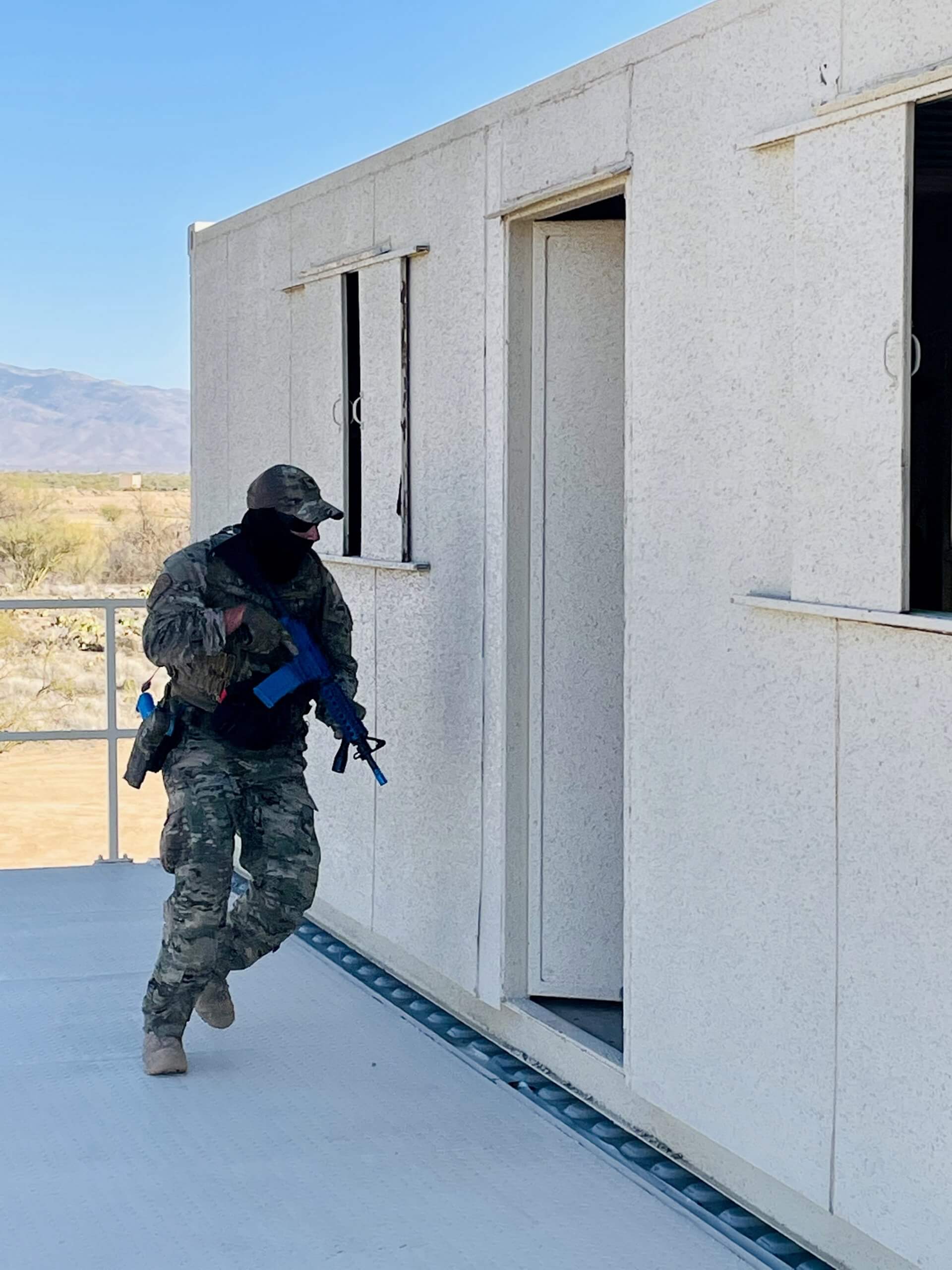
Here are definitions of some concepts we teach you about in our classes. Sometimes different trainers use different words to mean the same things; this glossary will hopefully help you clarify some of the “tacticool” words that get bandied about by gun gurus.
Administrative Reload–An administrative reload can be done on a hot range without pulling the pistol from its holster. Simply reach your thumb or finger around from underneath the grip, press the magazine release, pull out the old magazine, and slide a new one in. Not to be confused with a Proactive Reload (see below), although some instructors say “Admin Reload” when they really mean Proactive Reload.
Active Shooter Event (ASE)–A MCI (mass casualty incident) where the killer(s) has or have a firearm or firearms. Active Violence Events where the killer(s) have edged weapons, and vehicle rampages, are often erroneously reported as Active Shooter Events by the media.

Active Violence Event–A killing (or attempted killing) spree. Often referred to as Active Shooter Events, active killers can also use knives, bats, swords, automobiles, poison gas, or bombs–basically anything that can be weaponized. On 9/11, the terrorists weaponized airliners. We used to define these as anytime there are 4 or more killed, not including the bad guy(s). That definition is changing to include any time someone is attempting to kill or maim strangers, as opposed to a specifically targeted killing where drug dealer A murders drug dealer B. There is more violence these days than in the recent past, but the broadened definition makes it look like a drastic change, when really the broadest change has merely been in our operational definitions.
African Carry–One of two preferred ways to sling a long gun behind one shoulder (see Sling Arms) with a two-point sling. In African Carry, the long gun is butt up, muzzle down, behind the SUPPORT SIDE shoulder. It is preferred when it’s rainy for reasons which should be obvious with a moment’s thought. Of the one-shoulder “sling arms” carries, African is the fastest to engage from, and the least likely to slide off your shoulder accidentally. Preferred by hunting guides and trackers in the African bush. Of the one shoulder sling carries, African is my favorite.
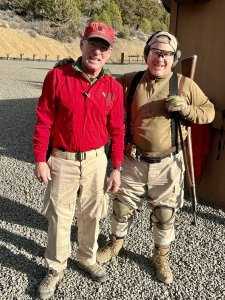
Aggressor–has two different meanings that might be relevant in defensive training circles, Either,
- An assailant or potential assailant; the one who picks a fight. Or,
- An Air Force term for OpFor, a role player who simulates a bad guy.
American Carry–The other of two preferred ways to sling a long gun behind one shoulder (Sling Arms) with a two-point sling. In the US military, Sling Arms means muzzle up carry. If your muzzle is up behind you with the sling across one shoulder only, it should be on the same side as your dominant eye, which is the primary shoulder you should shoot a long gun from, regardless of your handedness, unless field conditions dictate otherwise (see Mirror Image below). Muzzle up behind the dominant side shoulder is American (as opposed to African) Carry, although Aussies, Thais and soldiers of other militaries had hat brims that folded up on one side to make room for a muzzle up rifle. One of several downsides to slinging muzzle up is that it puts a heavy portion of the long gun’s mass over the point where it hooks onto your body, making it more prone to sliding off your shoulder. See Slingology for more.
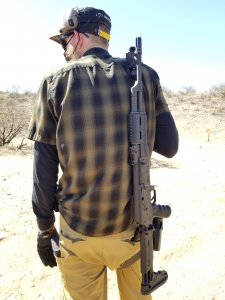
Antelope Principle–Whenever a group of pronghorn antelope beds down, whether it’s 2 antelope or a whole herd, at least one is always facing the other way to watch their back. Try to be like them.

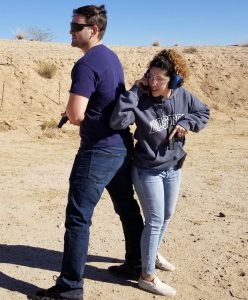
Appendix Carry–Refers to a specific location on one’s waistline. For a right handed pistolero, appendix is roughly over the identically named portion of your intestines. For a leftie, it’s left of the navel in front. Appendix can be inside or outside the waistband, although it hides better inside. If your belly is flat enough to tolerate it, it hides better (particularly for guys or gals with big pecs and / or associated adipose tissue, who wear non-clingy fabrics). Perhaps the best advantage of Appendix is the ease you can draw from it while on your back. The ease with which one’s support hand can clear a cover garment away from Appendix carry is another advantage; the support hand need not reach all the way across one’s front. “Mexican” (holsterless) carry is often, but not always, in the appendix location.
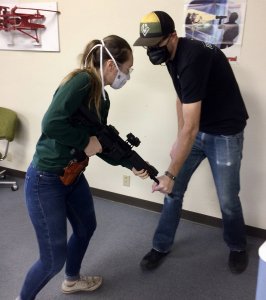
This carbine retention student (in green) carries her revolver in Appendix, as well as a OWB (an outside the waistband) holster, openly carried (not concealed). FYI, the carbine has been demilitarized (rendered incapable of firing) for this training.
AOR (Area of Responsibility)–Your lane. The part of the battlespace you are responsible for. It can be a designated field of fire but if you’re moving with a team it’s often a few hours on the clock (with 12 o’clock usually being your direction of travel). With a couple, your job might be to watch your spouse’s “6” (from 3:30 to 8:30 or so) to make sure nobody sneaks up from behind. If there is a civil disturbance in your neighborhood, Junior might be given the responsibility for watching the side yard from a window upstairs, while his sister watches the other way, dad watches the alley, and mom watches the front–or whatever.
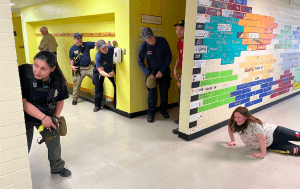
Area Target–As opposed to a Point Target (see). This concept is more familiar to soldiers than to civilians. You should become familiar with it, because you may be IN an Area Target. An Area Target may be so far away that someone shooting at it cannot hope to single out individuals. Rather, fires directed into that area are intended to hit someone, anyone. The bullets don’t have your name on them; they are addressed “To whom it may concern.” The Route 91 Harvest Festival in Las Vegas was a classic area target. It was 450 meters from where that wannabe sniper was holed up on the 32nd floor. A Marine can hit a non-moving target at 450 meters, but that bozo in the Mandalay Bay didn’t need that level of skill. He just poured bullets into the crowd. See Area Targets: A Tango’s Dream for more info.
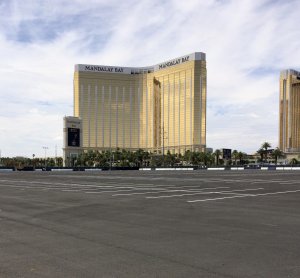
ASR (Active Shooter Response) Rifle–An ASR rifle is something you keep in a lock box in your vehicle, mainly for one mission: putting down a rabid dog who is, say, shooting up a parking lot or sniping at cars from a freeway overpass. It’s something we use ONLY in the first couple minutes after an active shooter event kicks off, usually if the bad guy is in an open area, and the good guys are still a few minutes out. If you let the killing continue, the body count will pile up. Also, the longer such a situation goes on, the more on-duty protectors will arrive, and the greater the likelihood that they will mistake YOU for the bad guy (see WHEN We Unlimber an ASR and Hazards of Self-Deployment in the article ASR Rifles and ASR Med Kits). The ASR fills a niche similar to a military “designated marksman” rifle, about halfway between a standard issue M4 and a sniper rifle. NOT to be confused with the brand name Aero Survival Rifle.
Assailant–The person attacking you, or a person who preys on others.
Automatic–Sometimes, people use the term “auto” or “automatic” when they really mean semi-auto only. In common usage, “.45 auto” refers to the semi-automatic Government Model and its clones. That GI .45 goes “Bang! Bang!” rather than “Rat-tat-tat!” Hence, the term automatic can either mean Full-auto or Semi-auto fire (see below).
Bad Guy–like Airman, rifleman, and able seaman, Bad Guy is a term that started as masculine but now applies generically to either gender. We still use it for two reasons:
- It is widely understood, and “bad person” just sounds silly.
- Bad guys are, far more often than not, just that: guys, as opposed to gals. In Lone Wolf Terrorism, one of my issued texts from FBI CTIOps (Counterterrorism Investigations & Operations) school, author J.D. Simon devotes the entire fourth chapter to “Where Are the Women?” Simon says that women sometimes participate in criminal / terrorist organizations as members (SLA), or even leaders (Baader-Mainhoff gang), but females rarely go bonkers and kill scores of people on their own. Females have been partners in suicide-pact active killer pairs; examples include San Bernardino, the Walmart in Las Vegas, and STEM School Higlands Ranch (at the STEM school, one of the perpetrators identified as male but was biologically female). Female Suicide Bombers often follow their husbands into martyrdom.
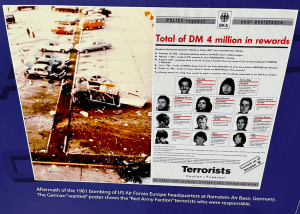
All of the above assailants / terrorists are, for our educational purposes, “bad guys.”
Ballistics–The study of what happens to a bullet from the moment of primer ignition till it comes to a stop. There are 3 types of ballistics: Internal, External, and Terminal (see each for more into).
Battery–No, not as in D-cell. When a firearm is “in battery,” the bolt or slide is all the way forward in its closed position, and the breech face is as close to the chamber as it can be. An artillery battery is a group, unit or cluster of cannons / howitzers / mortars or combination of field pieces.
Bayonet–An Edged Weapon which mounts onto a long gun (usually a rifle or carbine, but sometimes onto a trench shotgun). When attached, a Bayonet converts the firearm into a short, field expedient spear (a type of Pole Arm). Combatants are only very, very rarely impaled upon bayonets, although historically, few have had the intestinal fortitude to stand their ground in front of a line of charging enemy troops with bayonets affixed to their rifles. Although Bayonet charges became far less frequent and effective after the invention of the machine gun, Bayonet training persists in some militaries as a means of inculcating fighting spirt, or Warrior Ethos. For a great deal of prolixity on the subject, read Bayonets in the De Chalybe Vulnifico (edged weapons–literally, “on the steel which causes wounds”) section of this website.

Bayonet Lug–An extension a few inches aft of the muzzle of a rifle (or shotgun) which permits a Bayonet to be affixed.

Gun-banning legislators include Bayonet Lugs as one of the defining features of the so-called “Assault Rifle.” In theory, having Bayonet Lugs on their rifles would permit gang-bangers to participate in what one ATF deputy director said would be “the world’s first drive-by bayoneting.” Such arbitrary and capricious bans of specific features, rather than the intended or actual use, of firearms have proven to be entirely ineffective in preventing crime.
For example, the MAK-90s had their bayonet lugs ground off, and their pistol grips replaced with kinder, gentler thumbhole stocks, so they could meet such cosmetic import regulations. On 20 Jun 1994, a madman armed with a MAK-90 rifle killed 5 and wounded 22 others at the Fairchild AFB hospital. The lack of those evil “Assault Rifle” features did not, and could never, prevent premeditated murder.

Beaten Zone–The area where bullets strike the ground, usually dispersed throughout an oval area. Primarily applies to machine gun fire.
Below Line of Sight Fire–Shooting from bent elbow / retention positions, usually at close contact range, where the sights cannot be used.

Bent Elbow Fire–Shooting with the gun-side elbow bent, usually for retention purposes. Could be angled down (in retention) or up (to prevent shoot through issues). A type of compressed hold.
Beyond Line of Sight Fire–Shooting from an angle where the sights are not on a line between you and your threat. Below line of sight fire is one type of beyond line of sight fire. In beyond line of sight fire, the gun may also be at or above eye level. With pistols, this could be reaching around a hostage’s head to for a contact shot on the hostage taker, or reaching around your spouse who is rolling around on the floor in the clinch with a home invader. With long guns, beyond line of sight fire can be with the stock over the shoulder, say when scanning over the lip of a dumpster in clearing operations. With either, it could be reaching across to shoot down through a windshield (say, you were putting away the shopping cart when a guy jumps in your car and is about to drive off with your kids).
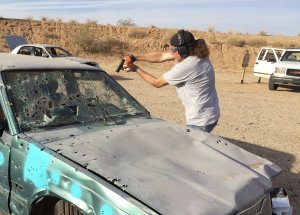
BFA (Blank Firing Adapter)–A device, usually screwed into the front of the barrel, that takes the place of a bullet to provide enough back pressure for the gas system to cycle the operating system of a firearm. BFAs come in two types:
- Box, or plug
- “Hollywood” or internal cylinder
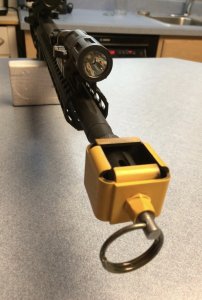
Bladed Stance–Standing with your support side toward the target, as if snowboarding or riding a skateboard. Preferred in some martial arts. Before rifle plate body armor was common, police academies taught the bladed field interview stance, a way to keep one’s strong side hip holster away from suspects when talking with them on a street corner. If you are wearing armor, you would be better advised to square your hips and your belly button (and the plates of your armor) toward the threat, if known. See Shooter’s Pocket.
Block Officer–military equivalent of a Range Safety Officer. Block Officers are shooting coaches responsible for a certain number of students on the firing line. Works in conjunction with a Tower Operator (see). Block officers primarily watch muzzle direction. They also ensure compliance with the required course of fire, check to make sure weapons are cleared or holsters are secure, and go forward with the students to analyze targets and give feedback on performance.
Blue on Blue–A “friendly fire” incident resulting from improperly identifying another good guy as a bad guy. We never shoot at sounds, or at anything else we have not properly identified (Rule 4). Remember, there’s nothing “friendly” about friendly fire. Blue on Blue might also be used to describe a Crossfire situation. We defeat Blue on Blue with our voice. An armed good guy in Joel Osteen’s megachurch were heard yelling “Blue! Blue! Blue!” when he came in contact with other good guys.
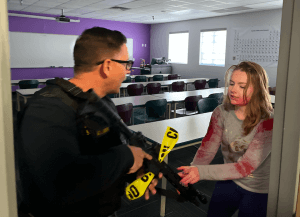
In the Rescue Taskforce exercise pictured here, an officer who has failed to identify himself enters a classroom containing wounded victims of an Active Violence Event. Fearing that the killer has returned, the victim “jumps” him as he makes entry. This actually happened at the McDonalds in San Ysidro. The potential for tragedy in Blue on Blue is great. Hero John Hurley shot a cop killer, only to be killed by responding police.
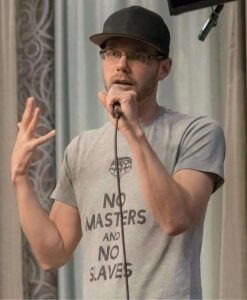
Bore Line–An imaginary line running down the center of the barrel and out the front of the gun. We use the term primarily to illustrate concepts when referring to exterior ballistics, what the bullet does after it leaves a barrel (the trajectory, another invisible line, is an arc that starts along the bore line at the muzzle and drops off from there). A rearward extension of the bore line runs through the firing pin channel in the middle of the slide and out the back of the gun. When discussing Grip and Hold, it’s important to remember that the higher the bore line is above the hands holding the pistol, the more leverage the recoil will have to flip the pistol up after it is fired. With a rifle, the bore line is actually pointed slightly up, rather than horizontal, when your sight line is horizontal.
Boat Tail–A bullet, usually a spitzer (pointed) bullet, with a tapered back end to make it more streamlined.
BorTAC–The Border Patrol’s national tactical team; their equivalent of SWAT.
Brewing Fight–A fight that is likely to happen, but you are not yet actively, directly under attack. You have some prior indication that trouble may be coming. Brewing fights may initially involve deception on the part of the perpetrator. If you read the signs correctly, you have time to be more proactive when the fight is brewing.
Carbine–A shorter rifle, usually one that fires pistol bullets or intermediate cartridges. See Carbines vs Rifles for details.
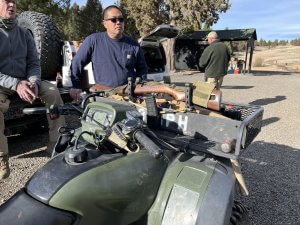
Carry–As a verb, it means to be armed, usually with a concealed handgun For example, “Do you carry?” or “Are you carrying?” (something you might ask your gun owning friend as three unsavory looking characters approach), or “Thank you for carrying to keep us all safe.” As a noun, carry refers to the state of being armed. When preceded or followed by a modifier (for example, African Carry or Open Carry or Carrying Concealed) the phrase refers to the way we are toting a weapon around.
Carry Condition–The level of readiness of your firearm. Jeff Cooper defined four levels of readiness based on where the ammo is (or isn’t) in the pistol. For more detailed information, read Alert Carry Conditions.
- Condition 1: Round in the chamber, charged (loaded) magazine inserted, hammer back or striker fully cocked. With firearms that have a safety, the manual safety is ON. With the venerable Government model (M1911 and its many clones), as well as with ARs, Condition 1 is called “cocked and locked,” as the safety cannot be placed on until the hammer is cocked back. When the US military adopted the M17 (SIG 320), they insisted that it be retrofitted with an external manual thumb safety like the M1911, even though the striker physically cannot be released until the trigger is pulled (see Condition 2).
- Condition 2: This applies specifically to Double Action (DA) pistols and revolvers, although you can also (ill-advisedly) carry a Government model this way if you manually lower the hammer. It is identical to Condition 1, with a round in the chamber and a charged magazine in the pistol (or loaded revolver cylinder) but the hammer or striker is forward / down, so it must be cocked (either via the trigger or manually) first, in order to fire. A Beretta M9 with the hammer down over a loaded chamber is in Condition 2, regardless of the position of the decocker / safety, as is (arguably) a chamber loaded Glock or SIG 320 that has no external manual safety. The Glock striker is half-cocked when the trigger is in the forward position.
- Condition 3, otherwise known as “Israeli carry,” has a charged magazine inserted, but NO cartridge in the chamber. Condition 3 seems to work for the Israelis, and is probably advisable with shotguns or ARs transported in vehicles. However, it has several downsides. Sometimes (and more appropriately) called Half Load.
- Condition 4 (sometimes called “Condition Zero”), has nothing in the gun. A charged magazine may be stored elsewhere, ready for insertion, as long as you have enough time (and 2 hands) to load the firearm. Condition 4 is legally required during storage or transport in some states. Some jurisdictions require the magazines to be unloaded as well.
Cascabel–That doorknob looking thing sticking out of the back end of an old-fashioned, muzzle-loading, black powder cannon.

CATM (Combat Arms, Training, and Maintenance)–Air Force small arms instructors and repairmen–the “Red Hats.” Formerly SAMTU (Small Arms Maintenance and Training Unit). For many years it was its own career field; kids who shot well in basic training might be recruited into SAMTU / CATM to teach other Airedales how to shoot, without ever having used or carried firearms outside a firing range. In the 1980s there was a push to make CATM training more “tactical” and less marksmanship oriented; to which many CATM instructors replied, “As soon a you give ME some tactical training, I’ll be glad to pass it on.” For that and other reasons, in the 1990s, the Air Force made previous experience in the Security Forces (to at least a 5 skill level) a prerequisite for assignment to CATM. I understand they have recently changed it back to a separate career field. The name was shortened to simply Combat Arms, although they still repair firearms in addition to teaching and qualifying USAF personnel to carry guns. Not to be confused with what the Army calls Combat Arms (see below).
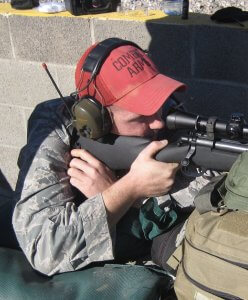
Center Axis Relock (CAR)–A bladed, close range shooting system developed by Great Britain’s Paul Castle. As the body pivots around one’s vertical center axis, you re-lock your support hand further around the front of your support hand.
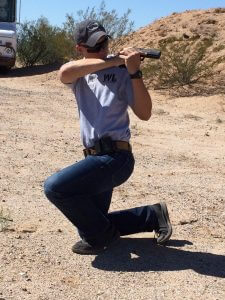
Central Nervous System (CNS)–The brain, brain stem, and spinal chord. Hits to the CNS have the greatest likelihood of resulting in the immediate incapacitation of your assailant. CNS hits may not be necessary with rifles and shotguns but they may be the only thing that does the trick with pistol bullets, which are relatively underpowered.
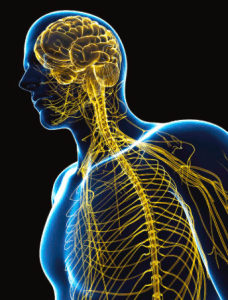
CFLCC–Pronounced “see flick.” Coalition Forces Land Component Commander. Usually the head Army honcho in a given theater of operations.
CFLCC Arming Conditions–Conditions of small arms readiness for US troops in a given area (such as “the Green Zone”), as dictated by the CFLCC. Sometimes influenced by Status of Forces agreements with the host country. Very roughly analogous to the Carry Conditions (see). CFLCC arming conditions are designated by color, thusly:
- Green: Like Condition 4, with nothing in the gun. Often required in cantonment areas, but sometimes outside the wire as well. Does NOTHING to prevent negligent discharges, as Green perpetuates the dangerous notion that such a thing as an “unloaded” firearm exists. Also puts our troops at far greater risk.
- Amber: Charged (loaded) magazine inserted, but nothing in the chamber. With pistols, only moderately less dangerous for our troops than Condition Green, for the same reasons.
- Red: Round in the chamber, safety (if any) on. For M-4s and M1911s, it’s cocked’n’locked (Condition 1). For M9s, M11s, and other Double Actions (see), it’s Condition 2.
Clinch–A fight at grappling distance. Like freeways, often used in conjunction with “the,” e.g., ” . . . when in the clinch.” Spelled with an e (“clench”) in some of the literature.
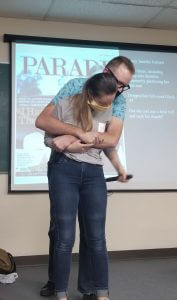
Close Contact Distance–Within two arms’ reach of your opponent (about 2 meters or less). Where most crimes, and most pistol fights, take place. Given that bad guys use deception to get closer, or can put on a sudden burst of speed to close the distance, close contact holds should be used within 3 meters.
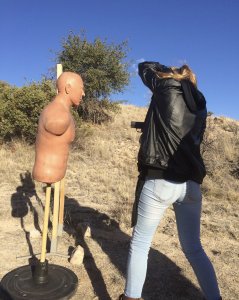
Close Order Battle Drill–How to move and shoot around your buddies. It was hugely important in the era of the smooth bore. Without training, shooting and reloading with 5 foot long, muzzle-loading muskets around other people would be dangerous slapstick at best. At worst, it would get you and your teammates killed. To get the timing and critical positioning right, soldiers needed to practice close order battle drill extensively. It’s just as important today that you practice moving safely around your family in the close confines of your home.
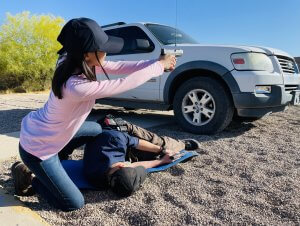
Cold Range–A firing range where the rules state that firearms must be unloaded first and last, before and after you do anything else with them. The concept has some little merit with brand new students, if for no other reason than to give them practice loading and unloading. Perhaps counterintuitively, “cold” ranges are actually, statistically, more dangerous than “hot” ranges, because cold range procedures program the dangerous notion that such a thing as an unloaded gun exists. Also, unloading is not a combat skill, it is an administrative skill. Immediately unloading (or decocking) our gun after we shoot it could be detrimental to our health, if we’re in that habit the one time in our life we get into a gunfight.
Confidence-Competence Feedback Loop–When you have early success at a skill or set of skills (say, basketball), you feel good about practicing it. The more you practice it (with proper coaching and methodology), the better you become, and the more confident you are. The two feed upon each other. This is one reason why instructors should make every effort to insure their students have at least a few early successes, and to use challenging but doable systems (such as balloons or steel targets) that provide immediate feedback of properly executed performance. As the student improves, increase the challenges.
Combat Arms–In the Army, Combat Arms refers to the big 3 on the pointy end of the spear:
- Infantry
- Armor / Cavalry
- Artillery
In the Air Force, Combat Arms is the section of the base Security Forces unit responsible for training all personnel to use their issued small arms. USAF Combat Arms instructors wear red hats when they work on the firing line. Formerly called CATM (see above).

Combat Dispersion–Spreading out your people or assets so that they can’t all be taken out by the same threat or event. For example, when we lived in Wyoming, our family had three cars. All three were parked on the same side of the street. A teenager in a ’74 Ford LTD dropped her Metallica tape, reached for it, crossed the centerline, and smashed all of our cars together like an accordion. If we’d been practicing the principle of Combat Dispersion, we would have parked at least one on the other side of the street, and still had something to drive after that.
“I want to see plenty of beach between men. Five men is a juicy target; one man is a waste of ammo.”
–“Tech Sergeant Horvath,” Saving Private Ryan
Complex Attack–When active killers use more than one method (guns and bombs, vehicle assault followed by a knife attack, etc). The Columbine killers used bombs as well as guns (although thankfully, those bozos did not know what they were doing with either, or the carnage would’ve been much worse, as they intended).
Complex Coordinated Attack–When 2 or more killers, acting in conjunction, use more than one method to assault people. May be disbursed over a wide geographic area to overwhelm civilized response, sowing confusion and terror. The 13 Nov 2015 bombings and shootings in Paris by at least 7 Islamic extremists were a complex coordinated attack.
Complex Motor Skill–A skillset with a lot of different “moving parts.” Fighting is inherently a Complex Motor Skill; it requires us to be on top of several different combat methodologies at the same time. For example, in a fight we may need to be adept at contorting our body to make the best use of cover while at the same time reloading, returning effective fire, and / or communicating. Complex Motor Skills are usually learned by breaking the skillset(s) into basic components before putting them all together in scenrio-based training. Not to be confused with a Fine Motor Skill, although some well meaning but less educated instructors may use both terms interchangeably. A complex motor skill can (and should) make use of Gross muscle groups and movements when possible.
Compressed Hold–Shooting from something other than full arm extension. A continuum, from moderately bent elbows to one handed retention holds by the ribs.
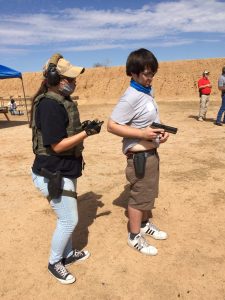
Cone of Fire–Applies primarily to machine guns. A burst of bullets occupies a roughly conical space as they fly. The cone starts narrow and then gets wider the further the bullets are from the muzzle of the gun.
Confined Space (when fighting)–A place where you cannot readily break contact. Confined spaces include elevators between floors, and aircraft cabins in flight, but they also include just about every room in your house or office building, if he’s between you and the door, or if trying to climb out the window will get you stabbed or shot in the back. Not to be confused with Confined Space Rescue (see TacMed Terms).
Contact Weapon–An instrument, such as a knife or club, that requires proximity, permitting direct contact between the weapon and the recipient, to injure. The “big 3” contact weapons are:
- Edged (anything that pokes or cuts)
- Impact (blunt instruments like baseball bats)
- Flexible (for example, a bike lock on a chain)

Controlled Pair–Two individually aimed shots in fairly rapid succession. Technically, with a controlled pair, there are three sight pictures: before the first shot, before the second shot, and follow through after the second shot. As opposed to a Hammer Pair, which is two shots so fast there is no time to re-acquire a sight picture between them. Controlled pairs and hammer pairs are both disingenuously referred to as “Double Taps” because it sounds cool. But the term double tap fails to differentiate between aimed and target focused, body indexed fire. A hammer is a hammer, and a controlled pair is a controlled pair.
Coordinated Attack–An assault perpetrated by two or more bad guys. Usually applies to two or more active killers, although it can also involve a covert Layoff Man (see). As opposed to a Lone Wolf attack.
Cross-Chest Carry–has the rifle hanging diagonally in front of the operator. The butt is near the dominant side shoulder, while the muzzle points at the ground off to the opposite side. Almost always, the sling is run over the dominant side shoulder and under the support side arm.
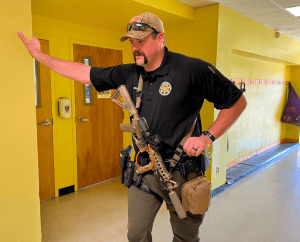
Cross Dominant–a person who is right handed but left eye dominant, or vice-versa. Such a person might carry a handgun in a right side holster but fire a rifle primarily from the left shoulder (or vice-versa), using their dominant eye to look through the sights. See Eye Dominance.
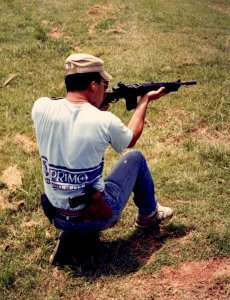
Cross Draw–a holster set up at an angle, on the other side of your belly button from your dominant hand. Prone to some retention issues, and requires special handling when drawing on a firing line (a right handed shooter with a cross draw holster should be on the left side of the line to avoid flagging others during the presentation). Can be useful during long road trips of if you are the chauffeur of an executive protection detail.
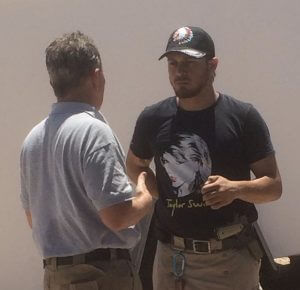
Crossfire–happens when we don’t pay attention to what is behind our assailant, or what our partners are doing, and either they or we or both end up on opposite sides of the assailant from each other. Our bullets might miss or over penetrate the assailant and go past to hit our partners. On 20 Jan 1989, San Jose, CA Officer Gordon A. Silva was killed by a round of buckshot fired by another officer at a killer between them. Some trainers might use the term Blue on Blue to describe a crossfire type of friendly fire incident where the other good guy (the one on the receiving end) is not noticed, as opposed to misidentified. In Heloderm classes, we practice getting assailant role players in an L, specifically to help you learn to avoid crossfire issues.
Crown–The last part of the barrel to touch the bullet as it leaves the gun. Changes in the crown over time change your external ballistics, and hence, your accuracy. See Recessed Crown.
Cruiser Ready—Condition 3 (see) for shotguns. Recommended since the hammer of many shotguns, especially worn shotguns, CAN drop if the shotgun is bumped (this is not common, but it has happened). In classes, I sometimes use the trigger group from a Remington 870 to demonstrate this. It has resulted in holes being blown out of police cruisers from the inside, as they hit pot holes.
Deadly Diamond–can mean one of two things, tactically.
- In executive protection (see), the Deadly Diamond is the sad limitation of varying one’s route to and from work. No matter how imaginative and time consuming you make your alternate routes, THEY ALL HAVE TO START AND END AT THE SAME 2 PLACES: HOME AND WORK. Those two locations are the pointy ends of the varied route diamond. Most ambushes take place on the front porch or driveway.
- In close to medium range ambush response, the Deadly Diamond might be the route taken by you and a partner to avoid both being targeted at the same time. It starts with forward oblique movement by both partners; one goes forward to the left, and the other forward and right. When you get to the outside corners of the diamond, with your assailant roughly in the apex of an L (you and your partner being on the ends of the L), turn suddenly into the assailant. If a bad guy is tracking you with his muzzle, he starts to catch up about the time you and your partner have him in an L. If you turn suddenly toward him, his muzzle might swing past you. Better yet, he is shooting at your friend instead of you, which leaves you clear to blind side him with a flying monkey tackle. If you are armed, you may forego the second half of the diamond and simply shoot him from the ends of the L without any crossfire issues.
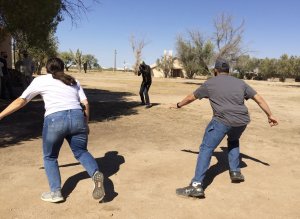
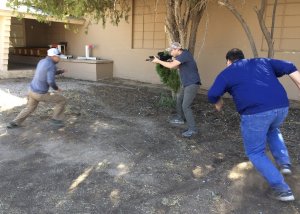
Decision Shooting–drills in which not every target should be shot, forcing the student to THINK before pulling the trigger. Decision Shooting drills often involve IFF (see below), and are sometimes called “Shoot / Don’t Shoot” drills, or Threat Discrimination training (see).
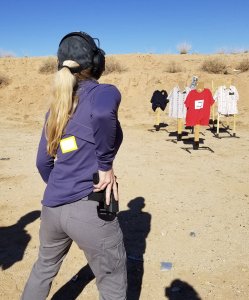
Default–Our Plan A. What we intend to do in response to a given stimulus, absent any extenuating circumstances. For example, with rifles, we generally default to shooting at the upper center of mass, for a few different reasons:
- The torso is easier to hit / harder to miss
- Rifle bullets zip through most soft body armor
- Rifle bullets tend to be effective “1 shot stoppers” when fired into the body
In contrast, we might default to a head shot with pistol, since pistol bullets are often stopped by body armor, and pistol bullets into the torso are not guaranteed to put a man down immediately.
Defilade–when you or the bad guy are not in a direct line of sight from the person pulling the trigger, or the person looking. The person on the receiving end has bunkered down behind or around something solid that will protect them from enemy fire (we call that Cover, as opposed to Concealment). A person in Defilade is protected from Direct Fire weapons such as rifles but not from Indirect Fire weapons such as mortars, grenades, and tossed pipe bombs.
Demilitarized–rendered incapable of firing, usually by preventing the chambering of live ammunition. Weapons may be Demilitarized for training, display, or for importation as war trophies. It’s important to use Demilitarized, rather than just “unloaded,” guns when practicing Off-lines, Disarms, HTE, or other forms of physical fight training / sparring activity.
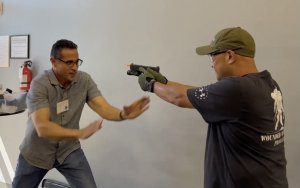
Detachable Box Magazine–A Magazine is a source of stored ammunition. Detachable means it can be removed from the weapon and replaced with a charged magazine (“charged” means that the magazine is loaded with cartridges). DB Mags may or may not be shaped like a box, but they are generally rectangular when viewed from the top. They may be banana shaped or trapezoidal from the side.
Direct Fire–shooting at something you can see, with a projectile launcher that shoots more or less flat for practical purposes. Contrast with Indirect Fire.
DGI (Direct Gas Impingement)–a gas operating system in which gases vented out of the barrel push (impinge) directly on the bolt carrier. DGI has fewer moving parts to break but depends on a relatively light bolt carrier and tight tolerances around the bolt carrier. Also, more carbon gets blown directly into your action, gumming up the works. All of the above make DGI systems more prone to stoppages, if not regularly and properly maintained, than, say, gas piston operated systems. The original AR15 / M16 series and standard M4s use DGI, although piston operated upper receivers are available. It should be noted that despite it’s higher maintenance, DGI systems have killed oodles of bad guys in their time.
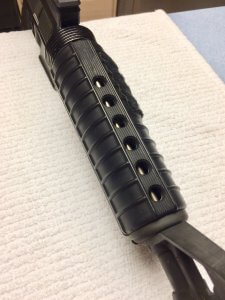
Disarm–The process of taking another person’s weapon(s) away from him or her. You can Disarm a person at intermediate range by holding them at gun point and ordering them to drop their weapon. In close range interpersonal confrontation, a Disarm can be achieved with empty hands, even against the other person’s will–IF you know what you are doing, and have practiced Disarming skills extensively. However, if he or she is pointing a gun at you, you will never succeed at Disarming that person unless you Off-line the muzzle–point it in a safe direction and control it–beforehand. Off-lines and Disarms are among the very first skills Heloderm teaches in Defensive Pistol classes, so you will understand how very easy it is to Disarm YOU, and take active measures to prevent that. WARNING: OFF-LINES AND DISARMS SHOULD ONLY BE PRACTICED WITH INERT REPLICAS OR DEMILITARIZED WEAPONS. FINGERS SHOULD BE OUTSIDE OF TRIGGER GUARDS WHEN YOU PRACTICE DISARMS, LEST YOU WANT TO BREAK YOUR TRAINING PARTNER’S TRIGGER FINGER.
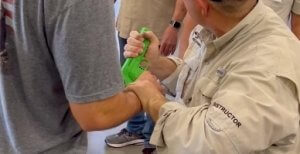
Dominant Eye–See Eye Dominance and Cross Dominant.
Dominant Hand–Your go-to hand. Most people are right handed. Even ambidextrous people tend to favor one hand or the other for particular tasks.
Dominant Side–with a handgun, the hand or arm corresponding with your handedness. I am right handed; thus my right side is my Dominant Side. My right hand is my “Dominant Side hand.” With a rifle, your dominant side is most often the side of your dominant eye (see Eye Dominance)–but not always (see Cross Dominant).
Double Action (DA)–a trigger system capable of both cocking and releasing the hammer. Most DA systems can be cocked (either manually, in the case of a revolver, or by the slide, in the case of a pistol). When the hammer is cocked, the trigger only performs a single action–releasing the hammer. Cockable systems are referred to as DA / SA, or Double Action / Single Action, to differentiate them from DAO, Double Action Only, systems which do not permit the hammer to stay back. The trigger pull of DA / SA pistols fluctuates significantly between long, heavy DA and short, light SA. DAOs are always long and relatively heavy, but they are consistent from shot to shot.
Double Tap–Two shots in fairly rapid succession. At the risk of sounding snobbish, the term “double tap” is an over-simplification, as there are two different ways to shoot two rounds in fairly rapid succession. See Controlled Pair and Hammer Pair. The idea that if one round is good, two are better is not new. Air to Air and Surface to Air missiles are often fired in salvos. Back when the pros were all carrying around single-stack .45s with 7 + 1 shot capacity, firing two shots (ONLY) was a good way to double you chances of hitting, and doubling your effectiveness (if you connected with both), without blowing off half your ammo (only 25%, to be precise; saving 75% for his friends or other contingencies). But there never has been anything magic about 2 and only 2 shots. With a higher capacity pistol (15 to 17 rounds or so), you could shoot him to the ground, however many shots that took. Now that everyone is carrying around lower capacity pocket rockets, pairs of shots may be making a comeback.
Draw–the Presentation (see).
Drop, The–“The Drop” is short for when the bad guy has “The Drop on someone,” or for when you have The Drop on him. A person has The Drop on another when they have beaten them to getting their gun out and are already covering them with the muzzle. It IS possible to Draw or otherwise move against The Drop, but one must know what they are doing and the effort is not to be undertaken lightly; as by the time someone has The Drop on you the odds are already heavily in their favor. Were it not for the OODA process, it would be impossible to move or Draw against The Drop.
Dry Practice–can be done in the rain, although it’s not recommended. In the firearms world, Dry Practice means going through the appropriate motions of marksmanship or manipulation without any ammunition in the gun.
CRITICAL SAFETY TIP: “I thought it was unloaded!” is a frequent lament after negligent discharges. Since the 4 Universal Caveats of Firearms Safety (4UCFS) apply AT ALL TIMES, there are certain very specific procedural rules for Dry Practice. The first is to ALWAYS POINT AT A BACKSTOP THAT WILL CATCH AND ABSORB AN ERRANT BULLET. One of the others is to only hang your Dry Practice target AFTER you have cleared out your firearm, and TAKE THE TARGET DOWN BEFORE RELOADING. When you load back up for alert duty, say “I am now in defensive mode with this firearm” out loud. Your spouse will think you crazy, but it saves marriages the hassle of living through the potentially tragic aftermath of attempting just one more dry press after loading the pistol about the time the phone rings and you get distracted.
EAT–Part of the PESTS EAT FAST protocol developed by Randy Harris. Things you must do right now if you find yourself in a fight. EAT stands for
- Explode off the X
- Attain a position of advantage (or lesser disadvantage)
- Take the fight back to them
Not getting shot takes precedence over shooting back, but you must take the fight back to them eventually or they will wear you down and / or catch up. We demonstrate this in Heloderm classes with Tom and Jerry drills, and other demonstrations.
Edge–The sharpened, cutting portion(s) of an Edged Weapon‘s blade; the part that shined like Meatloaf and his girlfriend in “Paradise by the Dashboard Light.”
Edged Weapon (EW)–a Contact Weapon that cuts or pokes, including knives, swords, spears, axes, and screwdrivers. When flung from a bow, a broadhead arrow is a Projectile. When held in the hands and thrust at an opponent within arms’ reach, without the assistance of a projectile launching bow, that same broadhead arrow is an Edged Weapon.
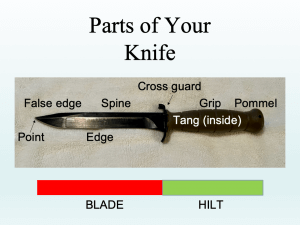
Emergency Reload–another word for Reactive Reload (see). Loading when you have to, not when it’s convenient. For example, when you are in deep kimchee in the middle of a gun battle, and you shoot the gun dry. See also Empty Gun Reload below.
Empty Gun Reload–a Reactive Reload (see). When you have shot the gun dry. Get the empty, useless old magazine out of your way, insert a fresh mag, and send your slide or bolt forward to chamber the top round. Then reassess the situation.
EDC (Every Day Carry)–What you have on you on a more or less daily basis. It might be handgun, and / or a folding knife, and / or a cell phone, and / or spare magazines, and / or house keys, etc. Your EDC should include a tourniquet and compressed gauze. Remember, “If it’s not within arms’ reach when you need it, it might as well be on Mars.”
Enfilade–When the line of your fire (the long axis of the oval beaten zone) coincides with the long axis of your target.

Picture a lawless future (or perhaps a present) when roving gangs of thugs are running the “LA marathon:” Shoot, Loot, and Scoot. Your family and a few of your neighbors decide to convoy out of there to your in-laws place in the country. The lead vehicle gets stopped by a felled tree, barricade of burning tires, or vehicles blocking the road. When they do, they are ambushed by men in a ditch beside the road. When you dismount, flank them, and shoot down the ditch, you have the ambushers in Enfilade. Bullets that miss the first bad guy will hit the one(s) behind him.
European Carry–slinging a long gun, muzzle up, in FRONT of your support side shoulder, with the sling strap across that shoulder only.
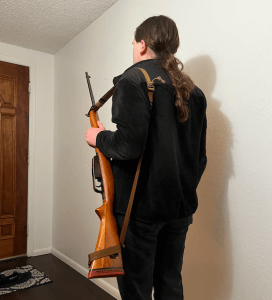
Executive Protection–employment or assignment as a body guard, even if the protectee is not an executive per se. You may never be hired to protect Jessica Alba or a German banker, but many executive protection principles also apply when you are with your loved ones at a restaurant, or anywhere else.
Executive Ambush–the targeted assassination (or attempted assassination) of a specific individual. We call it an “executive” ambush regardless of that individual’s employment status. Most executive ambushes happen in the front yard or driveway of the target’s home. The second highest number occur at or right outside the victim’s workplace. See Deadly Diamond.
Experience Fragment Training–Drills designed to replicate at least part of a bad situation you might find yourself in. Unlike most drills, which are practiced over and over to develop a reflex, you only need to do an experience fragment once or twice to get some benefit from it. We can never predict all the aspects of your once-in-a-lifetime death struggle, but the more experience fragments you have in your memories the less disoriented you will be when the real thing happens to you, because you will have experienced something similar before. For example, during a Krav Maga seminar, Eyal Yanilov told me “The first time you feel the cold steel of a gun muzzle pressed up against your temple should never be the FIRST time you’ve felt the cold steel of a gun muzzle pressed up against your temple.” Remember, however, that we never point FUNCTIONAL firearms at anyone who is not a deadly force threat, even if the gun is “unloaded,” because THERE ARE NO “UNLOADED” GUNS.
“It is of immense importance that the soldier, high or low, whatever rank he has, should not have to encounter in War those thing which, when seen for the first time, set him in astonishment and perplexity. If he has only met with them one single time before, even by that he is half acquainted with them.”
–Carl von Clausewitz, On War
External Ballistics–are what happens to the bullet in flight, i.e., between the muzzle of the firearm and the target. External ballistics are partially beyond your control. The wind changes, and with a long shot across a canyon or around buildings it may even be different during different parts of the bullet’s flight. But often, with proper training, you can predict and compensate for external ballistic factors with reasonable accuracy. For example, gravity is (for practical purposes) the same no matter where you are on this planet. At extreme range, we can count on spin drift happening.
Eye Dominance–All of us who have two eyes that see have one eye that our brain defaults to when processing visual inputs. Point at something small a ways away. Close one eye. Did the thing you were pointing at stay on top of your finger? If so, the open eye is your dominant eye. If it the object you were pointing at jumped off your finger when you closed one eye, the eye you closed is your dominant eye. You should be able to shoot and to aim your firearms using either eye (as well as with body indexed, target focused methods at closer range), but you should default to using the shoulder on the same side as your dominant eye most of the time when shooting rifles and carbines and shotgun slugs.
Failure Drill–Short for Failure to Stop drill. The classic failure drill is transitioning to a head shot if shots to the body fail to stop the threat (which is not unusual with pistols), although we might revert to Pelvic Shots in certain circumstances. In most failure drills, we practice Plan A (our Default) first, followed by a pause to see if it worked. If the instructor says “He’s still coming” or some such, you then execute Plan B. Real confrontations, however, rarely leave time for such plaintive introspection. You are just as likely to simply keep shooting at his center of mass till he hits the ground. You may (and probably should) also choose to practice Immediate Failure Drills (see).
Farnam’s Three Stupids Rule–see 3 Stupids Rule
FAST–Part of Randy Harris’ PESTS EAT FAST protocol. FAST is an acronym for things you should do after you get into a confrontation.
- Fight
- Assess–Is the bad guy down? Is he staying down?
- Scan your environment 720 degrees (360 degrees horizontally and vertically) for additional threats
- The T‘s (see Wyatt Protocols below)
FBI Flashlight Technique–One of the original ways proposed for integrating a hand held flashlight with a handgun during searches. With a proper FBI, the flashlight is held at or near arm extension above and away from you. Your pistol is held in the other hand. In theory, since bad guys shoot at lights, that should cause them to shoot beside you. In practice, reflected light off the walls and ceiling will pretty much tell him where you are, anyway. Although FBI has fallen out of favor, it’s useful as a niche technique. For example, cops approaching a car from the driver’s side (or lefties on the passenger side) might “lead with the light” in something like an FBI. Moving the light around away from you, and observing what the shadows do, can help you identify threats in the dark, or even give away someone crouching on the other side of an object from you. Neck Indexed is like a compressed version of FBI.

Femoral Triangle–see Pelvic Shot
Field Expedient–An improvised substitute for the real thing. If you don’t have a knife, you can use an ice pick, screwdriver, or (older style) potato peeler as a Field Expedient Edged Weapon (EW). A table lamp could be a field Expedient Impact Weapon. Rocks are Field Expedient Projectiles (when thrown) or Impact Weapons (when held in hand and used at grappling range).
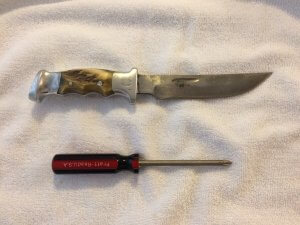
Fine Motor Skill–is something requiring dexterity of our finger tips. Before all the advances in robotics and laparoscopy, brain surgery required fine motor skill (it probably still does). The problem is, the deeper we are into the “fight or flight” reaction, the more our body will shunt blood away from our extremities and into our major muscle groups (like your thighs, so you can run farther faster) and our core organs (primarily your heart and lungs, to power those major muscle groups with the oxygen they need and to circulate around all the adrenal chemicals our body is doping us up with). Accordingly, we should avoid training to perform (and counting on performance of) Fine Motor Skills in a fight, although some Fine Motor Skills may not be avoidable. Not to be confused with Complex Motor Skills, although some instructors say “complex” when they really mean “fine.” See also Gross Motor Skill.
Flash Fight–a fight that starts before you realize you are in a fight. Your initial actions in a flash fight are reactive, rather than proactive.
Flash Suppressor–A device, usually cylindrical with fluted slots, which affixes to the front of a rifle to reduce muzzle flash.
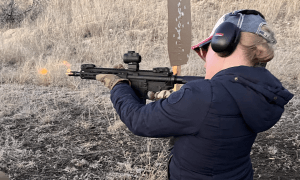
Flat–Describes the trajectory of a high velocity cartridge, with a bullet that travels so fast, and / or is so streamlined, the arc of its flight is insignificant at most practical engagement distances. All bullets have a curved trajectory that gets more arched the farther out you go, and all shoot flat a close range, but a “flat shooter” is one that doesn’t rise or fall much over a relatively great distance. One might say, for example, “This rifle shoots flat to about 280 meters” (or whatever distance), which is to say that beyond that distance the operator will need to hold over to compensate for bullet drop. See also Point-blank Range.
Flats–Portions of polygonal rifling (as opposed to land and groove rifling) in a barrel, between angles in the rifling. When viewed from behind, flats are like the straight sides of a stop sign or honeycomb, as opposed to the angles joining them.
Follower–A platform (like the floor of an elevator) that pushes up on the bottom round in a box magazine, or pushes back on the front of the (first loaded, last out) cartridge or shell in a tubular magazine. The shape of the follower, and the feed lips above it, can be essential for reliable feeding into the chamber. On most followers, there is a shelf that pushes up on part of the slide stop / bolt catch; after the last round is fired, the follower comes up, pushes up on the catch, and locks the bolt or slide to the rear. If the slide or bolt does not lock open after the last round, the culprits usually are, in order of likelihood,
- Fat thumbing down on the slide catch during the firing cycle;
- A weak magazine spring that doesn’t push up hard enough fast enough on the follower; or
- In rare cases, a broken follower.
Force Multiplier–Something that gives you an edge or enhances your capability. The term became popular during the cold war, when the US was vastly outnumbered. Technology such as our night vision, something we used to have a virtual monopoly upon, was supposed to make up in quality for their overwhelming quantity. If (and only if) you are trained to use it, a firearm can be a force multiplier in deadly interpersonal confrontation.
Force on Force (also written Force-on-Force)–the very best type of personal protection training. Force on Force can involve role-playing scenarios, HTE (human target engagement), off-lines, disarms, or sparring. Most of your practice should be dry / katas, but the second largest percentage of your training time should be force on force.
FRELIMO (Frente de Libertação de Moçambique)–A Marxist / Maoist / nationalist guerrilla organization which, with help from various ComBloc countries, successfully liberated Mozambique from 400 years of Portuguese administration in 1974. See Mozambique Technique.
Fully Automatic–means that the gun keeps shooting till you let go of the trigger or run out of ammo, whichever comes first.
Gas Operation–How some firearms operating systems work. As the bullet is being pushed through the barrel, it passes a small hole in the barrel. Hot, expanding gasses vent through that hole to drive the gas system, usually a piston (like in your car) that pushes back on the rest of the operating system, so your firearm can kick out the empty case and then stuff in a new cartridge. Gas systems usually come in one of three types:
- Gas delayed blowback, also called gas retarded blowback
- DGI (Direct Gas Impingement)
- Piston driven

With retarded blowback, the gasses pressurize a cylinder that slows the cycling of a pistol slide. For a more extensive look at the whys and wherefores of gas operation, and other operating systems, see Mind the Gas Port.
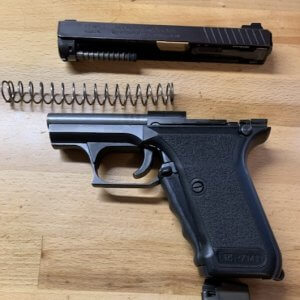
Getaway Driver–A person who waits outside in a running car while a robbery is taking place. Which you already knew. There are two things you do need to know about Getaway Drivers:
- Getaway Drivers are a threat to you and to responding police. On 16 May 1974, an allegedly “reluctant” member of the SLA emptied an entire magazine from a M1 or M2 carbine at a manager from Mel’s Sporting Goods in Inglewood, California, who tried to stop her SLA comrade as he was exiting the store.
- The weapon most commonly used by Getaway Drivers to kill and maim is the vehicle itself.
- Very few getaway drivers claim prior knowledge of the offense, and some very few might actually have been in the dark about their passenger’s intent. As Randy Harris points out, if your “friend” wants you to drive him to a shady apartment complex and wait outside for just a minute, that might be a clue that you are about to violate Farnham’s 3 Stupids Rule. “Friend need a ride?” Chris Rock asked, “Not so fast. Your friend may be crazy.” Refer to Rock’s highly informative video, How Not to Get Your Ass Kicked by the Police.
Government Model–a classic American design, copied throughout the world, based upon the US military’s M1911 designed by John Moses Browning. The M1911 and 1911A1 were standard US service sidearms from 1911 through the late 1980s, and have been in use by several units since. In its original configuration, it is a long, skinny pistol with a single stack magazine, usually (but not always) chambered with fat .45 ACP cartridges. It’s notable in that the Government model is (except for a few design variants) Single Action only, and must be cocked to use. It has no external manual decocker. Most LEOs who carry the Gov’t model carry it in Condition 1, with the hammer back and the thumb safety on, “cocked and locked.”

Graveyard Conditions–Describes the wind, or more specifically, the lack of wind, downrange. If there is little or no wind that will move your bullet left or right during its flight between you and the target, coonditions are Graveyard, so you need not Holdover to compensate. Look for smoke, waving grass, flags, or other indicators of wind. On warmer days, mirage may be visible near the ground. If the mirage does not appear to be moving left or right, conditions may be Graveyard.

Grazing Fire–When bullets are traveling close to the ground and (for all practical purposes) parallel to it. This usually applies over flat, level or gently sloping terrain. Technically defined as when the center of the Cone of Fire does not rise over 1 meter from the ground, it is more practically defined as when the top of the cone of fire does not rise more than 1.8 meters–the height of a standing man–above the ground. With 7.62x51mm machine guns, grazing fire goes out to about 600 meters from the gun. With grazing fire, the Beaten Zone (area where the bullets strike the ground) is long and skinny.
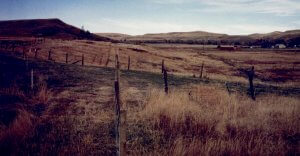
Green on Blue–In nation building operations, a Green on Blue is when insurgents infiltrate the nascent police force or army, either with a “plant” or by turning an existing member (either through radicalization or by holding his family hostage). The “green” indigenous soldier or officer then ambushes his own team (including “blue” US or allied advisors). Green on Blue is one of the most insidious, and most effective, ways insurgents use to erode trust between host nation and allied forces.
Grip–How your hand(s) interface with the pistol. Alternately, when naming the parts of a pistol, the grip or grips are the part of the pistol frame that your hand holds, usually containing the magazine well.

Gross Motor Skill–The art of barfing. Just kidding, although that is pretty gross. Gross Motor Skills are actions we perform with large muscle groups, say in our thighs or core. As opposed to Fine Motor Skills. Since Fine Motor Skills tend to deteriorate as our body shunts blood away from our finger tips to our major muscle groups (like our quads), our core (like our abs), and our core organs (heart, kidneys), it behooves us to practice firearms handling methods that make use of gross motor skills. For example, using your whole palm to strike the “ping pong paddle” of an AR series rifle, rather than poking at it with a finger tip.
Gun Hand–The hand attached to the finger that pulls the trigger, having the palm most in contact with the grip. If two hands hold a pistol, the gun hand is the one underneath the other. Usually, but not always, your “strong,” or dominant, hand.
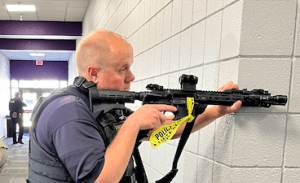
Half Load / Half Loaded–What Jeff Cooper called Condition 3: charged magazine (or belt of linked ammo) in the weapon, but nothing in the chamber. With a belt-fed, open-bolt machine gun (MG), linked ammunition is snapped in under the cover, but the bolt is in the forward position. With an open bolt submachine gun (SMG), the bolt is ridden forward and THEN a charged (loaded) magazine is inserted. Likewise with semi-auto pistols. Clint Smith of Thunder Ranch prefers the term Half Load. Half Load actually conveys the condition of the firearm accurately, even to the under informed, whereas Condition 3 is a technical term one either understands or doesn’t.

Hammer Pair–is pretty much what it sounds like. Hitting a close range bad guy with two shots as fast as you can pull the trigger. Theoretically, if you are aming at all, there are only two sight pictures in a hammer pair:
- The first, before the first shot, and
- The second, after the second shot.
The second shot of a hammer is NOT aimed; we depend upon a stable shooting platform (our grip, hold and stance) instead of finding the front sight again to keep the pistol pointed more or less in the same direction between the first and second shot.
Hammer pairs are a fairly close range technique. You may have anywhere from zero to two sight pictures. If he’s close enough to hit with both shots of a hammer pair, it’s likely you don’t need to aim (with the sights) at all; rather, we use target focused shooting methods if we’re close enough for a hammer pair to work (inside of 8 meters or so).
Hammers are sometimes called “double taps,” but then so are Controlled Pairs, which are two separately aimed shots (not the same as a Hammer).
Harries Flashlight Technique–Named after former Marine Mike Harries, this combines a bladed Weaver type stance with isometric tension to help you control recoil. Most techniques for using a flashlight require essentially one handed use of the handgun (well, they don’t call it a handSgun), but like the Weaver it was developed from, Harries is a truly two-handed handgun technique. The backs of the palms are pressed together after bringing the flashlight hand around UNDER (NOT in front of) the pistol hand.
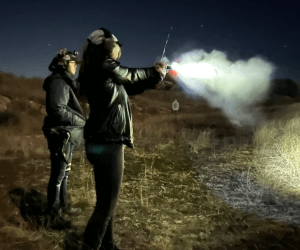
Done correctly, the support side elbow is down. Over time, the elbow tends to come up and out, because Harries can be very fatiguing. While the elbow being out provides zero recoil control, it should be noted that flashlights are used for searching and identifying targets, and tend to be dropped or ignored while shooting. A more horizontal support arm variation of Harries can be useful with SMGs and long guns.

Harries works best around the same side of a corner or cover as your gun hand, since it allows you to LEAD WITH THE LIGHT. If you lead with your gun instead, the light will bounce off your cover, blinding you and lighting you up for the bad guys to see.
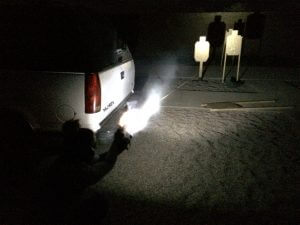
Hasty Sling–Using the carrying strap, or Sling, of your rifle to assist you in steadying your hold. As opposed to a Loop Sling.
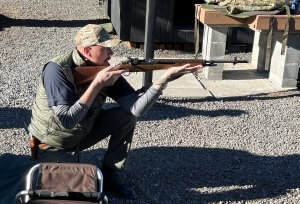
Hold–How your arms and hands work together to control recoil. Most recoil is perceived after the bullet leaves the barrel, so recoil control has nothing to do with marksmanship. It is, however, important to speed up follow-on shots. Since almost all bad guys require multiple pistol hits before stopping their aggression, rapid follow-on shots can be very important.
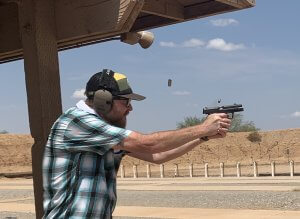
Hold Over–Where you must aim to compensate for either bullet drop (at longer ranges) or for the mechanical offset between the sight line and the bore line at close range. The latter is not really important with most pistols, but it is critical with ARs and AKs. Contrast with Hold Under below.
Hold Under–Some pistols, especially older European designs, came with sights that hit high at conversational distances on purpose, so you would be point of aim = point of impact at longer ranges. Since almost all pistol fights happen at conversational distances, you should hold under (aim lower) if your pistol hits high. If you’re really good with a rifle, you might also hold under a little at the Maximum Ordinate (see).
Hollywood Adaptor–A BFA (blank firing adaptor) that partially plugs a barrel internally. Usually, Hollywood adaptors are cylindrical, and have a small cylindrical tunnel running through their center. This tunnel permits some gasses (and, for movie or training purposes, noise / muzzle flash) to escape through the front of the barrel, while at the same time providing enough back pressure for the gas system to cycle the action of the firearm. IT SHOULD BE NOTED THAT HOLLYWOOD ADAPTORS, TO AN EVEN GREATER EXTENT THAN OTHER BFAs, CAN CAUSE CATASTROPHIC FAILURES IF LIVE AMMUNITION WORKS ITS WAY INTO THE GUN. This is more likely with Hollywood adaptors because they are not readily visible from outside the gun, and we can forget they are there. Procedural safeguards must be in place so all participants know there is a Hollywood adaptor in there.
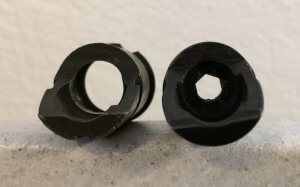
Hoplophobe–A person who is the victim of their own hoplophobia, although it may be safely stated that responsible gun owners and even law enforcement agencies can fall victim to hoplophobia on the part of the voting public.
Hoplophobia–A term coined by Jeff Cooper to describe irrational rear of firearms. Not to be confused with a healthy respect for the destructive potential of firearms (or chainsaws, or any other machines) in untrained or irresponsible hands. Hoplophobia, a condition often caused or at least exacerbated by the media, presupposes that firearms are not inanimate objects subject to the will of their operators but rather magical talismans (perhaps possessed by demons) with a will of their own to do evil.
Hot Range–the way Heloderm runs most of our training (except NRA classes, or when the hosting venue has mandatory Cold Range procedures). On a hot range, students are expected and required to manage their ammunition and keep their gun loaded at all times–just like in your office, if you carry concealed at work, and just like in a fight, which is ultimately what we are training you for. People who are programmed to unload their gun all the time have far more negligent discharges on and off the range. With a hot range, pistols are generally kept in the holster when not on the firing line, and can be reloaded without being pulled from the holster (see Administrative Reload above). Rifles on hot ranges are generally hanging on a sling when not being used. Ideally, working on hot ranges long enough leads to a condition where it doesn’t matter if the pistol or rifle is in hand, or where, as it will always be pointed in a safe direction, with the finger up along side the frame, unless it is pointed at a target. My friend and mentor “Slim” Pickens, a former director of safety for a Numbered Air Force, calls that “Safety through competence.”
HTE (Human Target Engagement)–A form of Force on Force training. When you are shooting, with paint pellets, marking cartridges, Airsoft pellets, or lasers, at living breathing, moving opponents. Far more effective than training to shoot flat, motionless pieces of cardboard, HTE requires certain very specific, and hard fast, safety procedures.
ICSAVE (Integrated Community Solutions to Active Violence Events)–A non-profit organization who’s mission is to educate our communities about how to keep the body count low when active killers attack.

IED (Improvised Explosive Device)–a homemade bomb. See IEDs: A Different Approach to learn more.
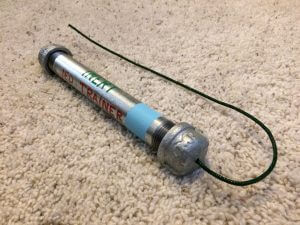
IFF (Identify, Friend or Foe)–The process of differentiating between allies and enemies. Any monkey can pull a trigger, and any moderately trained monkey can hit a non-moving target that has no will to live and is not trying to kill you. But bullets are like ICBMs: once they are launched, there’s little you can do to stop them. IT’S ABSOLUTELY IMPERATIVE THAT YOU ONLY SHOOT AT PERSONS WHO CONSTITUTE A DEADLY FORCE THREAT. Your training should include threat discrimination training as often as possible.
Immediate Failure Drill–A Failure Drill (see) in which we execute Plan B as soon as we’ve completed Plan A, without pausing to determine if Plan A worked. In reality, if you actually need to shoot someone, there will be very little time for reflective assessment over tea on the veranda while you determine if it worked or not. Rather, you will fire a burst at his center of mass and then immediately bring your sights up to his head. If his head is still there to hit–which is to say, if he hasn’t fallen down already–take careful aim and shoot him in the head, NOW. The rhythm of an immediate failure drill is “Ba-bam! Bam!” Even if he is close enough for a Hammer Pair (or a short burst of 3 to 5 rounds), there is still a slight delay before the head shot. Not to assess if your first burst of fire (to the upper center of mass) is working, but rather on the theory that a head shot MUST hit, so you don’t forget to aim precisely and slowly press the trigger. See CNS.
Impact Weapon–One of the three major types of contact weapon. An impact weapon is a blunt object used to strike a person. Examples include baseball bats, pool cues, batons, table lamps, folding chairs . . . Like the other contact weapons (edged and flexible), your assailant must be close enough to touch you with an impact weapon for it to work.

In Battery–When the components of your firearm are in the firing position; a round is in the chamber and the breech is closed.
Inchworm drill–A Kata in which two training partners start about 3 yards apart, facing one another with finger pistols, inert replicas (red / blue / yellow / green plastic imitation guns), or demilitarized pistols held at full arm extension. ONLY ONE PARTNER MOVES AT A TIME. One partner SLOWLY advances toward the other, to close the distance between them. As the distance between them closes, each partner slowly draws their pistol back to 3/4 extension, then 1/2, then 1/4 (about where the hands come together during the Presentation), and finally to a one handed retention hold, with the other (support) arm in front of them and their fingers up to protect their neck.
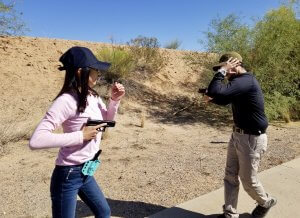
The advancing partner stops when they get about 4 or 5 feet apart. Then the second partner SLOWLY backs away. After taking one or two steps, the second partner leaves her or his pistol in the same point in space, and slowly back away from it till it is once again out at full arm extension. The first partner does the same, pushing their own pistol out into the void created by the retreating partner. When they get 8 or 9 feet apart, the second partner stops, and the first partner once again begins advancing. And so on, down the hall, till you get to the end, and then the first partner becomes the one backing up.
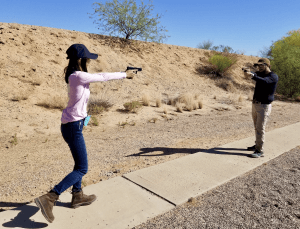
The purpose of the Inchworm drill is to forge subconscious spatial awareness of the fact that any time an assailant is close to you, you need to pull the weapon in hand back to where he won’t be able to off-line or control it. Almost all of our firearms training teaches us to keep the weapon out at full extension, only and always. The Inchworm drill is a way to avoid that Training Scar.
Incoming–When bad guys are shooting at you with something. Most commonly used to describe Indirect Fire, but can also mean Direct Fire. I can tell you from personal experience that even if you are a heavy sleeper, a comrade shaking you awake yelling “Incoming! Get your gear on!” will rouse you from your slumber in short order.
Indirect Fire–When you are behind cover, out of sight, or over the horizon from your antagonist, but they are lobbing rounds at you over your cover. The incoming could be mortars, artillery, rockets, IRBMs like the SCUD, grenades, or tossed IEDs.
Instinct–The hard wiring or firmware that was issued with your body. When you were born, your mom didn’t need to hold a “How to Breathe” textbook upside down between her knees for you to read. You already knew how, even though you’d never done it before. Some things we do in a confrontation are instinctive. Instinct can either help or hurt us. You tell your kids, “Get behind me.” That instinct was programmed into you genes when the threats we faced were fangs and claws. It does not work as well against bullets, which have only been around for 500 years or so. Ideally, we practice skills that do not run contrary to our instincts, but that may not be possible. For example, when we were lower on the food chain and lived outdoors, running directly away from teeth and claws made sense. You might, with sufficient motivation, outrun a bear. But you cannot outrun a bullet, especially in a confined space, regardless of your motivation, so we might need to train skills, like lateral movement, forward obliques, and off-lines, that run contrary to our instincts. When some instructors say, “You must train this till it becomes instinctive,” what they really mean is “till it becomes Reflexive.” Technically, you cannot make anything instinctive.
Instrumental use of a weapon–threatening someone, to get them to do something they would not otherwise want to do (get in the trunk, take off their clothes, let the bad guy tie them up, etc). The weapon may be used to harm someone eventually, and that may be the long-term plan, but right now, while the weapon is being used instrumentally, killing you is only an option. Contrast with Intentional Use of a Weapon below.
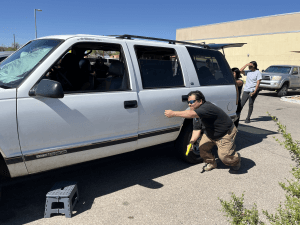
Intentional use of a weapon–the perp came here to murder you, and is in the process of trying to do that. If someone is actually trying to kill you, you have absolutely NOTHING to lose by resisting their efforts.
Intermediate Cartridge–A rifle bullet with less size and power than the spitzer pointed bottle necked full sized cartridges developed in the first half of the 20th century. 5.56x45mm and 7.62x39mm are common examples of intermediate cartridges.
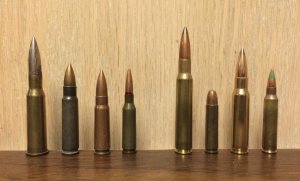
Internal Ballistics–Are what happens to your bullet before it leaves the firearm. They have to do with your cartridge and barrel combination; they determine the potential accuracy of your rifle. I say “potential” because a Boy Scout with a pocket knife can be a deadlier opponent than your stereotypical Berkeley professor with a belt-fed machine gun; it’s what you do with your equipment that counts. The quality of the ammo, the quality of the barrel, how clean the barrel is, whether or not the barrel is free floated, how much freebore (distance between where the bullet is seated in the case and the beginning of the rifling) there is; all these things and more affect interior ballistics.
Iron Sights–may be made of metal or plastic. We use this term to describe the traditional aiming bumps on top of a pistol, as opposed to the fancy electronic optics that have become popular of late. It should be noted that bad guys have been killed with iron sights (and with target focused, “point” shooting methods), quite effectively, for centuries.
Israeli Carry–Running the sling across your non-dominant shoulder, with the muzzle forward & down, and the butt back behind your armpit. This gets a long gun (rifle, carbine, shotgun, or SMG) out of the way, but readily accessible. I don’t think the Israelis invented this, and they are probably not be the only ones who carry that way traditionally, but if you look at photos of Israeli soldiers, most of those who are slung up still sling that way.

That said, the strap running over the dominant shoulder, the way we see many Tier 1 operators run their slings, seems to be catching on among the rank and file in Israel.
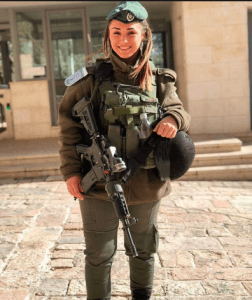
Jamming the Draw–see Stuffing the Draw
Jennifer Fulford drills–Practicing using your support (weak) hand only to fire, reload, and fix stoppages. The way Heloderm teaches this, the pistol starts on the ground, and your training partner smacks you hard on the strong arm deltoid, as if you’d been hit and dropped the gun. Named after a deputy with big, solid brass ovaries who did just that after being wounded multiple times in a gun battle, shooting two home invaders and leading to the surrender of the third.
Kata–In martial arts, a Kata is a form. Something you do to program certain motions into your subconscious muscle memory. Think Daniel-san’s “Wax on, wax off,” or Patrick Swayze by the lake in Road House. In the martial art of the gun (sometimes called “Ching-ching Bang”), dry practice is type of Kata. The Inchworm drill is another.
Knobkerrie (pre-20th Century historical / cultural)–A stick with a bulbous end, used by indigenous peoples in Africa. A knobkerrie was typically thrown at small animals for getting lunch, but was used as a club in combat with two-legged opponents. In some cultures a knobkerrie was a ceremonial accessory like a king’s scepter or an officer’s swagger stick; in others it was a primary instrument of war. The term comes from Afrikaans word for knob and the Khoekhoe word for walking stick. The British later used the same word for similar weapons in Australia and the Pacific. Also spelled knobkerry, knobkierie, and knopkierie.
Knobkerrie (WWI)–Trench club. British term for the truncheons used by both sides when raiding opposing trenches, usually at night. These were shaped differently, shorter and stouter than native African knobkerries. They were sometimes made from an empty grenade on a stick. Their primary use seems to have been quietly taking out sentries or bludgeoning enemy soldiers in their sleep, although they saved precious ammunition when used to euthanize dying victims of chemical attacks.
L–an ideal (or least bad) positioning relationship between you, a potential assailant, and your partner. When you have the bad guy in an L, you and your partner are 90 degrees off each other (the ends of the L), with your assailant in the 90 degree apex of a right triangle (the middle of the L). That way, you avoid crossfire issues (at least with each other; you still must be mindful of what’s behind your target). You will never start in an L, but you should practice maneuvering to get there, either before a Brewing Fight or as a response to a Flash Fight.
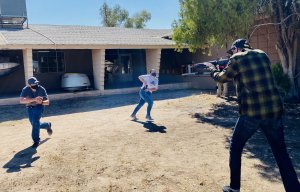
Layoff Man–a covert bad guy who pretends to be a bystander during an armed robbery or other criminal activity. The Layoff Man’s primary job is to back up the overt (obvious) assailant if the overt assailant steps into more than he can handle. The Layoff might also stick around afterward to give misleading descriptions to responding investigators (if most of the witnesses remember a white man in a red shirt, the layoff will swear it was a black guy in a blue and gold shirt). Lookouts and Getaway Drivers might also have a secondary role as a Layoff man. Women are less likely than men to engage in violent street crime, but Layoff Man is one of the criminal glass ceilings a female is less unlikely to break. Layoff men and women are one reason you, as an armed citizen, should be very circumspect about intervening in armed robberies of crowded stores, as armed citizen Joseph Wilcox learned too late in a Law Vegas Walmart on 08 Jun 2014. See also Sleeper, and an upcoming post on Defeating the Layoff Threat.
LEO–Law Enforcement Officer
Liberation Tigers of Tamil Eelam (LTTE)–A Sri Lankan guerrilla organization, widely credited for perfecting the suicide bombing concept. Also known as the Tamil Tigers.
Limited Skills, High Reps Course–A class which only covers a few specific skillsets, then drills those procedures over and over and over. At Front Sight, for example, you will learn ONE way to clear type III stoppages, and ONE way to do a proactive reload. Then you will practice them repeatedly till you can almost do them in your sleep. As opposed to a Survey Course.
Lone Wolf–A single perpetrator.
Lone Wolf Attack–When one person (perhaps exhorted to action by internet propaganda) assaults others with little or no outside logistical help, and zero on-site backup. As opposed to a Coordinated Attack. See also Layoff Man.
Lookout–a type of Layoff Man (see) who hangs out outside a store being robbed, or a stash house, to give warning of approaching police or rival gang members. Kids often play in front of a house with their friends, and sometimes by themselves. A youngster playing alone is not necessarily, or even typically, a lookout. But if the same kid is always hanging out outside the same house, never leaves no matter what the weather, and does not appear to be having a good time (the ones I’ve seen, or at least the ones I was later able to positively associate with the stash house, did not seem to be having much fun), he or she may be a lookout. What’s important for you, as an armed citizen, is that if you pay attention and notice a lookout outside, you are less likely to stumble unawares into an armed robbery in progress. A gunfight avoided is a gunfight won.
Loop Sling–Encircling your biceps with a sling, anchoring it to one corner of a triangle, that most stable shape, when constructing a stable firing platform with your arms, limbs, and rifle (another corner of the triangle being where the sling attaches to the front of the rifle). The back of the sling may or may not be attached to the rifle. Loop slings take more time to get into (and OUT OF) than a Hasty Sling, and are usually reserved for proactive situations (military snipers, police sharpshooters in protracted standoffs, or competition shooters).
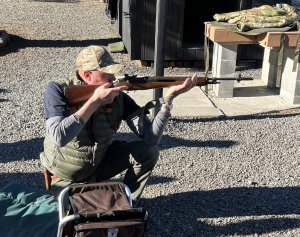
LTTE–See Liberation Tigers of Tamil Eelam
Lull in the Action Reload–A Proactive Reload (see). When the situation has calmed down enough for you to think about things like “How much ammo do I have left?,” so you top off the ammo in your weapons system.
M4–standard US military carbine, a shorter version of the M16 series.

M9–the US military’s standard sidearm from the mid 1980s through the late 20teens. Essentially a Beretta 92FS, chambered in 9x19mm (9mm NATO, AKA 9mm Luger / 9mm Parabellum).
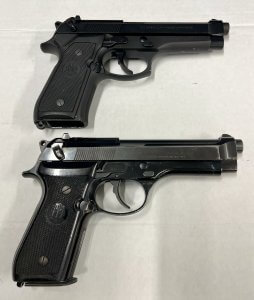
M1911 / M1911A1–Military versions of Colt’s Government model pistol (see Government model).

Magazine–a fixed or removable part of the firearm, that holds the ammunition and lifts it (or pushes it back) into position to be loaded into the chamber. Most magazines have the following components:
- Feed lips or guides that hold the next round high enough to be picked up by the bolt or stripper rail of the slide, and point the next round at the breech, or rear opening of the chamber.
- The follower, an elevator that pushes the rounds up to the feed lips.
- A spring that pushes the follower.
Magazines can be tubular; if so, they are restricted to flat or round nosed bullets (at the tip of the next bullet pushes on the primer of the one in front of it). A detachable box magazine also has the following components:
- A body, the vertical box or fuselage of the magazine, and
- A base plate, the bottom of the magazine.
The base plate may or may not be removable to make cleaning easier. YES, MAGAZINES SHOULD BE CLEANED. THEY SHOULD NOT BE OILED INSIDE.
The feed lips are the most critical part, and are the most easily damaged. A broken follower can fail to lock the slide open (or bolt back) after the last round. A weak spring can cause feeding problems. Like tires and oil filters, magazines are critical, but the shortest lasting and most “disposable” parts of a weapons system. The gun grabbers have learned this, which is why they advocate for legislation restricting magazines in any way they can. If new mags are unavailable when (not if) the old mags wear out, the guns will be useless.
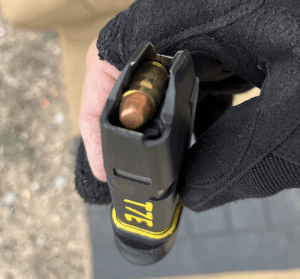
For example, the spring of this magazine has worn out. It’s not pushing up on the follower enough to push the top (actually the only remaining) cartridge up against the feed lips where it belongs. This can be caused by dirt or grit inside the magazine, but the spring should be strong enough to push past any schmutz that gets in there. Just like the shock absorbers on your car, all mechanical devices wear out eventually. Unlike your shocks, there isn’t any legislation prohibiting you from buying replacement shocks, or forcing you to buy shocks that only work half as well as those that were designed for your car.
Magazine Exchange–A type of Proactive Reload where a partially full, detachable box magazine is removed AND RETAINED on one’s person, before or after a fresh magazine is inserted in the firearm. There are many different ways to conduct magazine exchanges. Some are very complicated and rely to a great extent on fine motor skills which may be degraded in the aftermath of a ballistic confrontation. Generally, simpler is better, even if it is more time consuming. A magazine exchange is usually is not something we should be doing under time pressure. Rather, we do it when the tactical situation, and therefore time, permits. For example, you are preparing to leave cover (to get to better cover, escape, or to rescue someone) and you want to have a full weapon before you commit. Or, the bad guy is down, he does not appear to have any friends in the immediate area, and you just want to be ready if case more bad guys show up.
Malfunction–When your gun breaks. For example, after just under 4100 rounds, firing pin catch lever of my (first) government issued Beretta 96D snapped in half during range practice. That rendered my pistol completely safe for anyone trying to kill me. I could not fix that on the spot. It could only be fixed, later, by a gunsmith or armorer. When some people say the word “malfunction,” what they really mean is Stoppage.
Managing the X–A term I first heard from my friend Jay O. of Crosswalk Readiness. Ideally, we want to avoid being on the X, in the kill zone of the ambush, when the fight starts. Since we probably will be (all fights start as ambushes), our next best bet is to vacate the X as soon as possible after it starts. If a guy swings a baseball bat at your head, your head will feel better if it’s not there when the bat arrives at its intended destination. If you are in an elevator when a guy pulls a knife, creating distance will not be one of your options. You will have to manage that X, to wit: dealing with the knife, probably by controlling his knife hand and wrist. When we think about it holistically, ALL of the above methods–avoidance, escape, and controlling the enemy’s weapon(s) while we counterattack–are ways to manage the X.
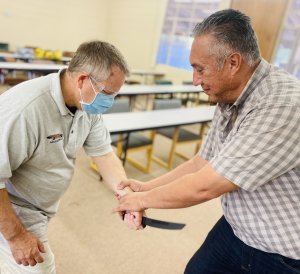
Manual of Arms–The way a particular weapons system is intended to be used, including any necessary manipulations to keep it fed and happy. Sometimes, an issuing agency requires a different manual of arms than the manufacturer intends. For example, John Moses Browning probably intended his M1911 to be carried “cocked ‘n’ locked” with a round in the chamber, the hammer back, and the safety on. When up / on, that “thumb” safety prevents rearward movement of the slide. Thus, the manual of arms for a cocked ‘n’ locked GI .45 calls for the thumb safety to be pressed down out of engagement to fire the weapon or to cycle the slide. However, the US Army would not permit MPs–even when protecting nuclear storage areas overseas–from having a round in the chamber (indeed, most army troops couldn’t even have ammo in their guns). With the hammer down, the external manual M1911 (and M16 / M4) safety can NOT be placed up / on. The US Army manual of arms would thus require cycling the slide (perhaps after inserting a charged, which is to say loaded, magazine) rather than manipulating the thumb safety in any way. See Alert Carry Conditions.
Maximum Ordinate–The highest point in a bullet’s trajectory. Bullets usually peak out at about 2/3 of the distance to the target. If your threat is at 200 meters, the bullet will be a few inches above your line of sight at about 140 meters. If your rifle is zeroed (i.e., the bullet drops back down through the bore line) at 200 meters, but your threat is at 140 meters, you might want to hold a few inches low (hold under) if precision is important (and if precision is achievable, given your aiming system and the situation).
MCI–see Mass Casualty Incident in the TacMed Terms glossary.
Mexican Carry–Tucking a pistol, without a holster, into one’s waistband, depending on the tightness of the belt to keep it in place. Most commonly in the Appendix position, although about where a kidney is, with the butt away from the spine, is also popular.
Holsterless carry is NOT recommended, especially for Glocks or other pistols with light / single action triggers.
“Mexican” Carry is popular among criminals of all nationalities (and also among legitimate undercover operators on assignment in non-permissive countries) because it allows one to ditch the handgun without leaving evidence on one’s person. Federal agents were able to establish a sicario’s “constructive possession” of a Smith and Wesson 9mm under his car seat, by matching the S&W to a holster on his person, in order to obtain a prohibited possessor conviction under 18 USC 922(g)(5)(A).
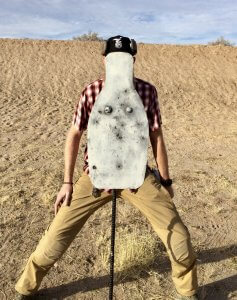
Milk Bottle Target–A target representing only the most vital portions of human anatomy. It has roughly the outline of an old milk bottle. Sometimes called “Q” targets, they can be steel (above), cardboard, or paper (below). In the image above, the guy behind should probably squatting just a little lower to get the target he’s behind overlaid on the areas it’s supposed to represent.
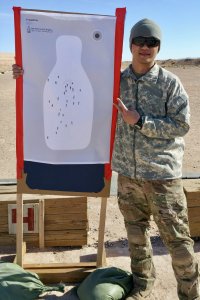
One can miss a milk bottle and still might have gotten a piece of somebody (say, in the hip or shoulder). But if you hit the Q, you know you would’ve gotten effective hits on a real subject.
Mirror Image–Holding a firearm the opposite of how you usually do. For example, a rifleman who typically shoots from the right shoulder might switch to a mirror image, left shoulder hold to make better use of cover. A left handed operator might switch to a right handed hold when slicing the pie around a corner to the right.
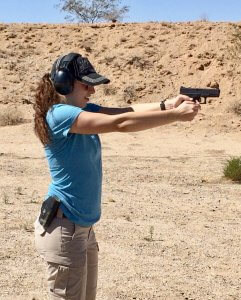
Mortise–A slot (usually with a T-shaped cross section) in the back (Pommel) end of a bayonet. Sliding the Mortise onto the Bayonet Lug of a rifle (or occasionally, a shotgun) mounts the bayonet, turning the gun and knife combination into a short, field-expedient spear.

MOUT (Military Operations in Urbanized Terrain)–Fighting in cities and towns (with or without a military), often room to room, but also in sewers, streets, and from rooftops, windows, or loopholes in adjacent buildings. You do not need to be in a military to learn, practice, and benefit from several MOUT principles.
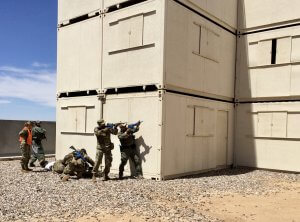
Mozambique Technique–Also called a Mozambique Drill. A Failure Drill. So-called because of an anecdote Mike Rousseau told his friend Jeff Cooper (“the father of modern pistolcraft”) about an experience during the Mozambican war of independence from Portugal (1964 – 74). Rousseau was at the airport in Lourenço Marques (now called Maputo), when he rounded a corner and found himself facing an AK-armed FRELIMO guerrilla “at about 10 paces.” Russeau shot the enemy combatant twice in the chest with his Browning 9mm pistol, but the insurgent was still on his feet. Rousseau attempted a head shot but in his haste snatched the shot down a bit, hitting the guerrilla in the neck at nearly chin level. That shot severed the FRELIMO fighter’s spinal cord and dropped him on the spot. Rousseau was doubtless not the first to use a CNS (central nervous system) shot to incapacitate an enemy, but he was the first to relay such an exciting story to Cooper, who was a prolific and popular gun writer at the time. Ever one to give credit where credit is due, Cooper called it the Mozambique, and incorporated it into his Modern Technique of the Pistol. Two LAPD SWAT officers, John Helms and Larry Mudgett, attended Cooper’s Gunsite training facility in about 1980, and brought Rousseau’s method back to LAPD. They renamed it a “Failure to Stop drill” to avoid any racist inferences on the part of the socially sensitive. Technically, Mozambique is a country, not a race, and “race” itself is a social construct; there are no sub-species of homo sapiens, as there is more genetic variation within any given “race” than there is between the so-called races–or so they told me when I was minoring in Physical (Forensic) Anthropology. Rousseau was an African of European descent, but he claimed his motivations were anti-communist, rather than anti-Black. I never read what color the guerrilla was. It might perhaps even be racist to assume he was Black. Although that was demographically likely, FRELIMO also had many Russian (and later, Cuban) advisors. Ironically, but not surprisingly, Rousseau was later killed in Rhodesia (now Zimbabwe), when Mozambique quite predictably became a staging area for communist guerrilla attacks into Rhodesia and South Africa–something Rousseau had been trying to prevent by fighting in Mozambique. Since then, the colorful Mozambique name has fallen out of favor, and has been officially replaced in almost all firearms training literature by the words Failure drill or Failure to Stop drill.
Muzzle–The business end of a firearm. Where the bullets come out of the barrel.
Muzzle Ring–the circular portion of a bayonet’s Crossguard that fits around the muzzle of a rifle.
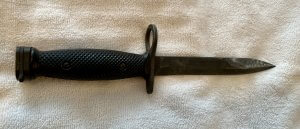
Natural Point of Aim (NPOA)
Neck Indexed–A way of holding your flashlight, over your support side shoulder. Neck Indexed, also called Security Guard Carry, lends itself well to repelling boarders with a flashlight strike if you are suddenly jumped from around a corner in the dark. NI can be used without a gun in your hand. It can also be used with a compressed one handed pistol hold, or with the pistol at full arm extension.
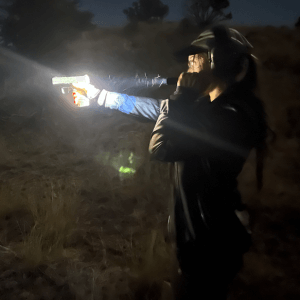
At full extension, Neck Indexed can illuminate the sights of your pistol with the “aura” or periphery of your flashlight beam, which should be centered on the threat (preferably, his face) and NOT shining directly on the back of your pistol. Neck Indexed is like a compressed version of the FBI Flashlight Technique.
Neck Indexed works much better around the support side of cover than Harries. When choosing a flashlight hold in relation to cover, barricades, or corners, remember to always LEAD WITH THE LIGHT. If you don’t, the light will bounce off your cover, blinding you.
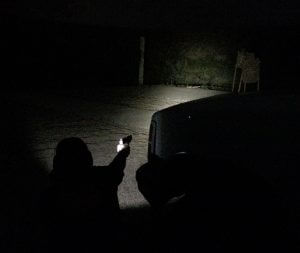
See also SFI / CCI Flashlight Technique.
No Shoot–A target, in or behind an array of targets, that represents an innocent bystander. Not all bystanders are innocent, but non-participants still should not be shot. It’s difficult to even notice anyone else when your attention is “tunneled in” on the person who is trying to kill you, but since your bullets (even the ones that hit) are not guaranteed to stay in your assailant, and since there is, more often than not, more than one assailant, you must maintain SA (situational awareness) of what’s going on around you, and especially behind your assailant (see Rule 4). Further, the vast majority of people are good; most violence is perpetrated by a core group of repeat offenders. Accordingly, your target arrays should include at least one no shoot, whenever possible. More No Shoots is better, but may not be practicable, depending upon your logistics and range layout. Your No Shoots can be quite obvious, especially at first. No need to be sneaky or pernicious about it, before students are in the habit of paying attention. You could just write “Don’t shoot me” in large letters on one of your targets, and then have your friend who does accidentally shoot it buy lunch afterward (there are much steeper consequences in the real world). But if your instructor has never given you any No Shoots, perhaps you need a different instructor.

Off-line–The most important part of close quarters combat against The Drop. If someone has a gun pointed at you, what you do with their gun has a lot more to do with the outcome of the fight than anything you do with your own gun. You may finish the fight with your gun, but at close range, if you don’t off-line his gun first, you will not live long enough to draw yours. Off-lining is, simply, pointing his gun in a safe direction. It’s the first, and most important step in any effective Disarm. In hand-to-hand fighting with rifles, an Off-line might be Parrying his rifle with yours long enough to close in for a bayonet thrust or butt stroke. Unless you are in your basement at home, the safest general direction to point the bad guy’s gun is UP, as Angela McQueen did at Mattoon High School.
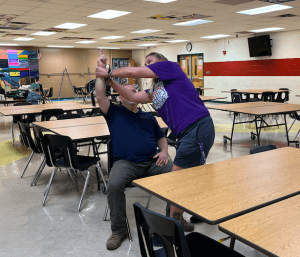
OODA–A concept developed by Colonel John Richard Boyd, a USAF fighter pilot and military theorist. It describes a continuous process or cycle by which we receive inputs from our environment and respond to them. OODA stands for
- Observe—What’s that in his hand? Why does he look so pissed off?
- Orient to the situation–That’s a knife! He’s coming right at me!
- Decide—Should I run? Grapple? Draw and challenge?
- Act–Placing the response option you chose into action.
Which, in turn, leads you to observe his reactions, and adjust accordingly, in a continuous cycle. OODA is not a checklist; it is a subconscious process we all do in confrontations, indeed, throughout our lives, whether we want to or not. It leads to certain predictable delays and behaviors on the part of both defenders and assailants. For more, read Robert Coram’s Boyd: The Fighter Pilot Who Changed the Art of War, especially Chapter 24.
Open Bolt LOADING–An administrative loading procedure for rifles and carbines. You start with a rifle that has had the bolt locked open, or lock it back yourself. Then, if your intention is to carry with a round in the chamber, insert a charged (loaded) magazine, and send the bolt forward, chambering the top round. You may choose to remove the magazine and replace it with one that has one more round (replacing the one that was chambered). You can also open bolt load a shotgun, but unless the shotgun will be in your hands from the time you load it, you will more likely carry a shotgun in Cruiser Ready (Condition 3), since many shotgun hammers CAN drop when bumped, even with the safety on.
Open Bolt REload–A type of Reactive Reload (see). When you shoot a rifle dry, the bolt should lock to the rear (unless it’s a Kalashnikov, H&K, or a few others). When it does, drop the empty magazine, replace it with a charged (or at least less empty) magazine, and send the bolt forward. With an AR-15 / M-4 type rifle, smack your whole palm against the left side of the receiver, striking the raised “ping pong paddle” portion of the bolt catch, to send the top round into the chamber. With a shotgun, the Open Bolt Reload is sometimes called a “combat” load. Leaving the bolt open (with a pump shotgun, the pump will be to the rear), slap the first shell in through the open ejection port. You may have to push it in if, for some reason, the elevator or shell carrier is in the up position. There is no need to actually shove the shell into your shotgun’s chamber; the bolt going forward will do that. Push your pump forward vigorously, or hit whatever button sends your semi-auto shotgun’s bolt forward. Time and circumstances permitting, you can then load additional rounds into the magazine through the bottom. Shotguns are hungry, and run out of ammo fast if not topped off frequently. Open Bolt REloads are more common with shotguns than Open Bolt Loads.
Open Carry–Packing heat where all can see, usually in a holster. As opposed to Concealed Carry. Open carry is required (when you carry) in some jurisdictions. Open carry is prohibited in others, even in some jurisdictions where concealed carry is permissible. If you have the option to carry concealed, open carry is generally not advisable in most social situations, as hoplophobes tend to become very anxious and fall into fits of apoplexy when they see a “G-g-gu-gun!” Open carry is also more susceptible to disarm attempts (bad guys usually don’t try to take what they don’t know is there), and totally forfeits any edge you might get from surprise.
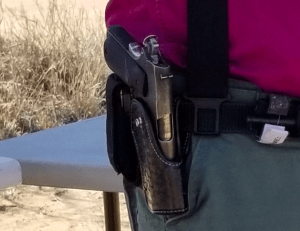
In some situations–say you are hunting with a rifle and carrying a pistol in a holster–open carry may be appropriate. Many people practice drawing (if they practice the draw at all) from open carry on the range, but then actually carry concealed on the street, which is a recipe for disaster.
OpFor–A trainer who plays the role of assailant / bad guy in scenarios. From the military abbreviation for Opposing Forces. The Air Force called OpFor role players Aggressors.
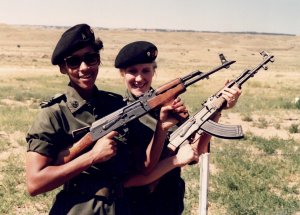
Outgoing–is not as commonly used as its antonym, Incoming. Outgoing fire is directed back at the bad guys. When you are new in country, as Major James Walsh was his first day in South Viet Nam, and you hear loud booms as he did when he was in the shower, it can be important to distinguish if what you are hearing is outgoing or incoming. It may even be advisable to seek cover until you are sure. If it turns out to be outgoing (it was NOT for Maj Walsh), it may be socially acceptable to encourage the troops with phrases like “Git some!” or “Send it!”
PADE (Perceive, Analyze, Decide, Act)–Another way of saying OODA, used by Navy SEALs, among others. See OODA above. For more info, refer to Combative Fundamentals: An Unconventional Approach by Jeff Gonzales (Prescott, AZ: Trident Concepts Research Group, 2002), pp. 33 – 35.
Pan–to Slice the Pie (see).
Parry–To Off-line a bad guy’s weapon just far enough and just long enough to slide in past it and counter attack, or Riposte. Parries are not very effective when going Empty Hands against The Drop; it’s better to get control, and keep control of the other guy’s muzzle direction rather than just swatting it away. However, with a fencing foil against another fencing foil, or with a rifle against an impact weapon or other rifle, the Parry can be quite effective–IF practiced sufficiently.
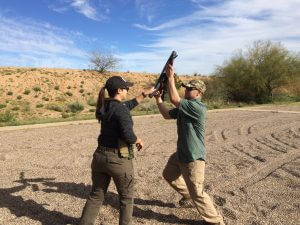
To defend against an overhead impact weapon strike with your rifle, first Block . . .
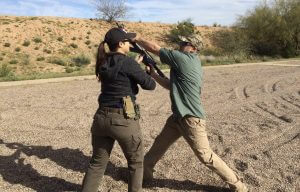
. . . then Parry . . .
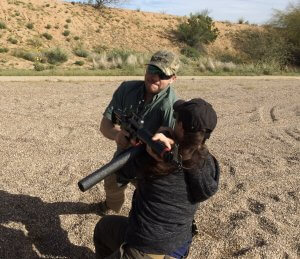
. . . then Clothesline . . .
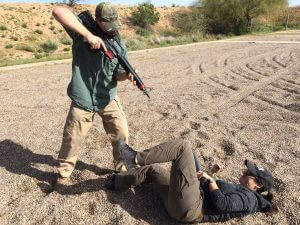
. . . and dump them.
NOTE: The above sequence was practiced with a piece of foam pipe insulation simulating the impact weapon and a Demilitarized rifle.
Pell–A post, sometimes wrapped in a thick material like carpet or old blankets, that you can use as a practice target for Edged, Flexible, or Impact weapon training.
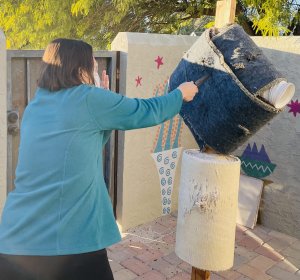
Pelvic Shot–Shooting at an assailant’s hip region. Although we almost always default to (upper) center of mass initially, pelvic shots were proposed as an alternative to shooting at the head, which is small, highly mobile, naturally armored against peripheral / glancing blows, and harder to hit, when the chest is unavailable. The concept was based on a bear hunting technique of shooting the bear in a front shoulder to render it less mobile, simultaneously less dangerous to the hunter and easier to finish with a brain shot. Some trainers will tell you that if you shoot a man in the pelvis or the thighs you will automatically hit a femoral artery. Don’t be silly. That’s possible, but not even likely. I have held a dead man’s femoral artery in my fingers. At the point where it crosses the pelvis (the point I cut down to it with a scalpel), the femoral is only about as wide as a standard-sized drinking straw. Even if it’s larger when the patient is alive and it’s engorged with blood, it’s not huge. If you do strike a major artery–the femoral isn’t the only one in the pelvic region–that’s a bonus, but don’t assume it will happen. The “top of the V” (see diagram) can be a handy aiming point. Pelvic shots can slow your assailant by damaging the structures that hold us up, specifically the pelvic ring, which is like a big catcher’s mitt in back.

Pelvic shots are a very legitimate alternative if the opponent is a hostage taker holding an infant or toddler between rescuers and his / her chest or head.
Personal Defense Weapon (PDW)–Although any weapon, from a grenade launcher to a potato peeler, carried to ensure you make it home alive is for “personal defense,” PDW usually refers to a unique type of firearm initially considered for downed aircrew survival. It was intended to have more teeth than the folding .22s that were sometimes in aircrew survival kits so they could shoot rabbits for food. Like the M1 Carbine (sometimes carried by Forward Air Controllers in Korea and Vietnam), the PDW was designed to extend the downed pilot’s reach, lethality, and ammo capacity over that of a handgun, without taking up a lot more space in an already cramped cockpit. Original PDW concepts often incorporated bullpup designs and forearm braces similar in concept to the wrist braces on the modern “AR pistols” and “AK pistols.” The PDW idea held some interest during the Vietnam era. It waned for several decades, under the assumption that a downed aircrew member’s best bet would be to lay low (gunbattles tend to draw unwanted attention), and surrender if caught. Issuing PDWs got renewed support after the last stand of Gary Gordon and Randy Shughart defending the crew of Super Six-Four in Mogadishu, when pilot Michael Durant wrote that his pistol-caliber MP5, though better than a pistol alone, lacked noise, intimidation factor, and punch. When they were overwhelmed, CWO4 Durant didn’t even bother pulling his M9 pistol (see Durant’s In the Company of Heroes). Jordanian pilot (and Sunni Muslim) Moaz al-Kasasbeh was burned alive by the godless savages of daesh near Raqqa, Syria. Al-Kasasbeh’s torturous death told all aircrews flying over Islamic extremists they might be better off fighting it out than expecting a captivity like Hogan’s Heroes. Ever slow to catch up in the small arms arena, the USAF only started including chopped M4s in aircrew survival packs in recent years.
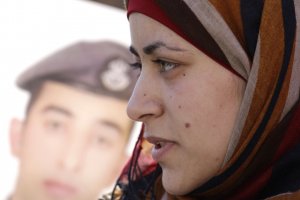
PESTSS (originally PESTS)–Part of the PESTS EAT FAST protocol. An acronym created by Randy Harris to help you remember what to do during encounters with unknown persons, to avoid getting into a fight. It stands for
- Pay attention
- Evade / Escape
- Stop their encroachment
- Turn on your Tape loop
- Step off the X and orbit them at least 90 degrees
Heloderm teaches you to add a third S, Set a mental trigger.
Pie Slicing–see Slicing the Pie
Plunging Fire–When bullets drop onto the target area from above, or strike a vertical target area from the side. The shootout with the Boston Marathon bombers was videotaped out a window by a Watertown, Mass resident. From his window on the 3rd or 4th floor, he was beside the terrorists, with zero Rule 4 (what’s behind your target) issues. If he’d been living in Arizona, instead of a state where the residents have been effectively disarmed, he could have videotaped it with a Go-Pro mounted to his AR-15, and ended that fight with vertically plunging fire before the cops fired hundreds of rounds horizontally into residences (and then locked down one of the nation’s largest cities for days, looking for one wounded, snot-nosed punk). If you are climbing out a fire escape to get away from a complex coordinated attack, and a terrorist in another building shoots at you, that is also technically plunging fire. With machine guns, plunging fire occurs at extreme ranges where the danger zone is confined to the Beaten Zone (see).
Presentation–Also called the draw. In gunspeak, the presentation is the process of getting your pistol out of your holster and pointing (presenting) it toward a potential threat. The presentation is a study unto itself, with a lot of nuance about how to clear a cover garment, when it’s OK to put your finger on the trigger, how and when to disengage any necessary manual safeties, etc. Usually we learn the draw step by step, then progress to making the steps all flow together smoothly. Most people only practice the presentation to a target that is directly in front of you, with your arms fully extended. We also practice drawing to a bent elbow, retention position, drawing to Sul, presenting the pistol directly to a target that is behind you, transition to pistol from long gun, and drawing while on the move.
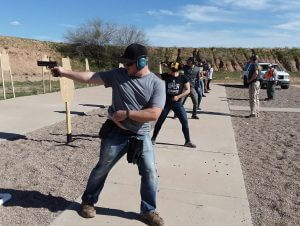
Point-blank Range–The distance over which a bullet shoots relatively Flat, so that a marksman does not need to hold over or under for practical accuracy. An AR zeroed with an initial intersection of about 50 meters will have a point blank range of about 200 meters. That means the bullet’s impact will never be more than a few inches above or below the line of sight out to 200 or so. As closely as most humans without a bench rest, a magnified optic, and a non-moving target that isn’t trying to kill them can hold, their point of aim will be, more or less, their point of impact out to that distance. NOTE: When Hollywood talks about “point-blank range,” they mean a person has been shot from close enough to whisper.
Press Check–Pulling back slightly on the slide or charging handle to ensure that there is a live round in the chamber. Something you should do, along with checking to ensure you have a loaded magazine, every single time you arm up. Murphy’s only exception to Rule 1 is the gun you need right this second to save your life. So be sure. Like the guy in front of the bank in Dirty Harry, you got to know.
Primacy of Training–The tendency of humans under stress to revert to performing a skill the way they first learned it, or have practiced it the most. For example, a cop learns how to handcuff a given way at the academy, and her first several years on the beat she handcuffs people that way. Then they come up with a different “approved” way to handcuff, and train that new way once a year or so. She might actually cuff the new way most of the time, because most subjects offer little resistance and might, if asked, cuff themselves. But if there is a struggle wherein the subject is combative, those cuffs will most likely go on the way she learned at the Academy. I have seen this happen on numerous occasions, with different types of skills, in the field. Ideally, then, we should teach new students a proper way from the git-go, rather than saying “that’s an advanced skill we’ll show you later.” Contrast with Recency of Training. See also Training Scar.
Primary–In the tactical arena, one’s primary is their go-to weapon. For an infantryman, that might be a rifle or machine gun. If s/he his dual armed, their Secondary might be a pistol. If not, it might be a knife or a bayonet.
Projectile–Something hurled at another. With guns, the Projectile is the bullet. It could also be an arrow from a bow, a thrown spear or a hurled rock.
Point shooting–Aligning the pistol with the target using arm or body indexed methods, rather than the sights. The pistol is almost always brought up into the line of sight between the shooter and the target, but the eyes are focused on the target.
Point Target–A person, or an otherwise small target like a window opening. As opposed to an Area Target (see), which might be a whole enemy camp.
PROactive Reload–Topping off the ammo in your gun when you want to, or at least when you can, rather than when you have to. With a pistol, it is also called a “magazine exchange.” With a shotgun, it might be topping off the magazine after you’ve shot a few rounds. Also called a “lull in the action” reload, since you might do it as one of your Wyatt protocols after the (first) bad guy goes down or scampers off.
Purge–This word has many other definitions, but in the personal protection arena, a purge is similar to, but not exactly the same thing as, clearing a building. USAF Security Forces purge nuclear weapons bays in Weapons Storage Areas (WSAs) before locking up and setting alarms. In that context, a purge is making sure nobody is staying behind. In the armed citizen context, a purge is what you should do when you come home, if your house has been deserted. Before you take off your carry gun, simply go through each room to make sure that you have not interrupted a burglary in progress. Briefly check to make sure the back door is still shut and locked, the window glass is unbroken, and the window screens have not been cut or pried off. Once you’re sure nothing is amiss, and nobody but you and yours are there, you’re free to unstrap your heater and store it in a safe, lowering your guard into Condition White. Purges are not paranoia–unlike a search and clear, you are not EXPECTING enemy contact–rather, purges are piece of mind. In the exceedingly rare event that you do find a stranger has been in your home, even if you’re pretty sure they are gone, back out and wait for the police (with their armed and armored friends) to clear the place. For more on purges, see Industry Day, 28 Nov 2020.
Purpose Built–A tool designed and manufactured for the reasons you use it. Examples would be a fighting knife, as opposed to kitchen cutlery. You might grab a steak knife out of the butcher block on your counter if there is a home invader in your dining room, but it is more likely to break, and won’t make as wide a wound, as a Purpose Built fighting knife.
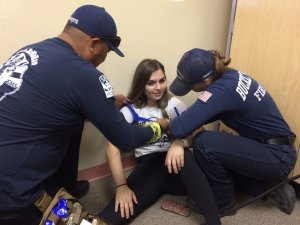
Another example would be a commercial tourniquet like the CAT or SOFT-T. You can improvise a tourniquet out of split pants legs and a tire iron, but by the time you find all the stuff you need and MacGyver it, your casualty may have already bled out. The opposite of Purpose Built is Field Expedient.
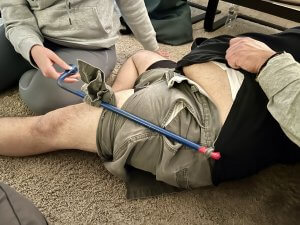
Quillion–A long Crossguard of an edged weapon. On a bayonet, the Quillion is on the opposite side from the Muzzle Ring. See also Hooked Quillion. For more information, see Appendix III of Bayonets.
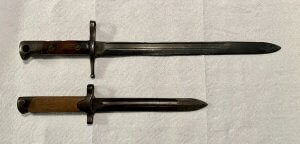
The Railroad Tracks–The line of attack between the person attacking you (your assailant) and you (“the X;” see below).
Range Safety Officer (RSO)–a person, who may or may not also be an instructor, whose main focus is on watching students’ muzzle directions, trigger fingers, and other behaviors to keep us all safe on the firing range. Sometimes called a Block Officer on military firing ranges. Heloderm is blessed to have a cadre of truly excellent, dedicated volunteer RSOs.
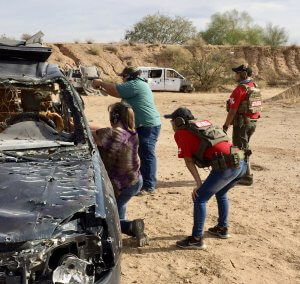
REactive Reload–Also called a slide locked, open bolt, empty gun or emergency reload. When you have shot the gun dry and need to reload immediately.
Reassess–Something you should do frequently when making Use of Force decisions. For example, we used to say “Tap, Rack, Bang” when describing immediate action for a stoppage. Now we say Tap, Roll Right & Rack, Reassess. The guy you were shooting at when your gun quit might have surrendered or scampered off by the time you get your stoppage fixed. For example, on 02 Sep 2018, Los Banos PD Officer Jairos Acosta got stabbed in a scuffle. He fired one shot before his pistol jammed, which is not unusual in scuffles due to impeded slide movement. Acosta tapped, racked, and shot again, stopping the assailant. The assailant’s father (who called the police to keep his son from stabbing him) sued the police. In Lam v City of Los Banos, a California jury determined that the second shot was unjustified (even though the whole thing took place in seconds) and awarded the father $2,750,000.00. For more details, see Ken Wallentine’s “Second Shot After Clearing Weapon Leads to Liability.”
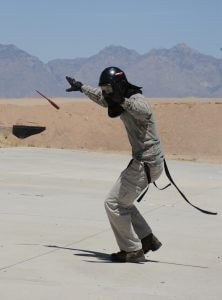
Recency of Training–When you have trained on a skill so recently that the short-term memory of it allow you to overcome having performed a different way earlier in life, or more often (contrast with Primacy of Training). Recency only works, if at all, over the short term. If you want to do it the new way when it counts, you’ll need to practice it the new way more times than you practiced doing it the old way. According to IALEFI, it takes between 2000 and 4000 repetitions to make a skill Reflexive, depending upon the complexity of the skill. It also takes at least that many quality repetitions of a skill to undo a previously established habit, and begin to do it the new way reflexively under stress.
Recessed Crown–A modification to preserve the accuracy of your barrel over time. If the crown is recessed, cut to end behind the outside of the barrel, it is protected a little from getting dinged up by your environment, but not necessarily from the greatest killer of barrels–steel cleaning rods, and overzealous cleaning from the muzzle end. See Crown.
Reflexive–When something is done without thinking in response to a stimulus or desire. For example, in your own home, if it’s dark in the room, you flip the light switch. You don’t think, “I wonder how to make it light in here,” or “Where is the light switch?” You don’t think about it much at all. It’s always been in the same place, and you’ve done it hundreds if not thousands of times. According to the IALEFI, it takes between 2000 and 4000 repetitions, to make a skill reflexive, depending upon the complexity of the skill. Drawing from under a cover garment, for example, is more complex than drawing from an exposed holster. Reflex should not be confused with Instinct.
Remedial Action–A pre-planned behavior if our Default / Immediate Action doesn’t work. For example, if our immediate action (Tap, Roll Right, Rack) failed to clear a stoppage, we might resort to Rip, Reload, Rack or even Lock, Rip, Rack, Rack, Tap, Rack before reassessing to see if our threat still needs to be shot.
Revetment–A wall or berm around something we don’t want hit with bullets or shell fragments. A must for, say, aircraft operating in high threat combat zones, but also desirable Stateside around critical infrastructure such as water wells and electrical substations. A Revetment need not be part of a fortified militia compound. Revetting your pool pump with, say, a slump block wall, might not only beautify your yard by hiding unsightly machinery, it also reduces noise, which your neighbors might appreciate.
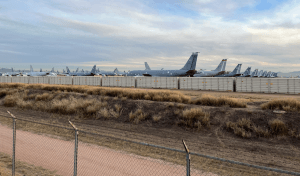
Rifling–Lands or flats running down the inside of a barrel in a spiral pattern, that impart a stabilizing spin to the bullet. Rifling is what gave rifles their name (although modern pistols also have rifling). Rifling differentiates rifles and pistols from shotguns and smooth-bore muskets. A barrel with rifling is “rifled.”

Riposte–an immediate counterattack. Usually performed after evading, Parrying, or controlling the other guy’s attack.
RSO–see Range Safety Officer
Rule 1—Treat every firearm as if it is loaded. One of the Four Universal Caveats of Firearms Safety.
Rule 2—Never point a functional firearm at anything you are not willing to destroy. The second of the Four Universal Caveats.
Rule 3–The golden rule of firearms safety: Keep your finger off the trigger, up alongside the frame, till you have made a conscious decision to fire.
Rule 4—Be sure of your target. Know:
- What (or whom) it is,
- What is behind your target, and
- What is between you and your target.
It’s not enough to read about the Rules; you must practice them for them to become habitual. In moving courses of fire, Heloderm places steel targets at random behind the target line. The steels are No Shoots representing innocent bystanders. If we hear a “Ding!” as you walk through the course, you weren’t paying enough attention to what’s behind your target, something you absolutely MUST do in the real world, and something that is much easier to write about than it is to do when that guy’s cavernous gun barrel has your almost undivided attention.
Rule 5—Secure your firearm(s). Not one of the Four Universal Caveats of Firearms Safety, but still a pretty good idea. The safest place for your firearm to be is ON YOUR PERSON. Whenever it is not on your person, and out of your sight, it should be locked up to prevent access to it by unauthorized, criminal or simply innocent or ignorant persons. The hoplophobes would prefer that it be disassembled, with cable locks through every possible component of the operating system, in a safe, in a locked and alarmed armory, in a secure facility, with all ammunition in a different time zone. All of that would, of course, render it completely useless for defensive purposes, which is what the hoplophobes would prefer (till they can pass legislation requiring that it be confiscated and destroyed). We give them ammo to disarm us, though, if we allow our firearm to be misused by those less responsible that ourselves. When it’s out of your sight, secure it. If you cannot lock it up, you should at the very least conceal it in a locked automobile or room, and (if the situation allows you to unload it without causing alarm or letting people know it’s there, which would defeat the purpose of concealing it), hide the ammo somewhere else.
Sabrina, The–Named for Kate Jackson’s iconic Angel, the Sabrina was a handgun carry frequently seen on cops shows of the 1970s and ’80s, until film and television producers started hiring more technical advisors, and downward pointing carries such as Weaver Guard and Sul became more popular. In Sabrina, the muzzle is pointed up at about the level of the face, and usually off a little to the side. The elbows are bent and two hands are almost always on the gun. The Sabrina actually had some legit proponents. It was, for example, part of Mas Ayoob’s StressFire system.
Although it looks silly, there are some situations in which the Sabrina may be quite appropriate–for example, when you are working your way up a flight of stairs.
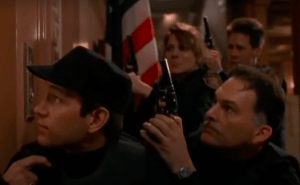
Sabrina also looks slightly less dorky than Temple Indexed, which is a one-handed Sabrina with the gun against your head. TI and Sabrina make sense if you are stepping over to check on a downed partner or to apply direct pressure to their wound or arterial pressure point with your knee.
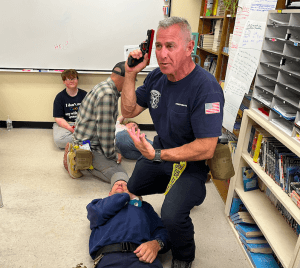
SAMTU (Small Arms Maintenance and Training Unit)–What US Air Force firearms instructors were called before they became CATM (and later, CA).
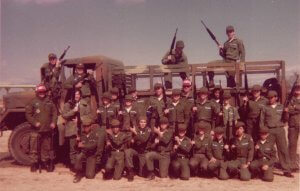
Secondary–a backup gun. If your Primary is a Glock 17, you might carry a Glock 26 or a J-frame Smith snubbie as a Secondary. If your primary is a rifle or carbine, your duty pistol will be your Secondary. In this photo, an Army Ranger transitions to his secondary (a pistol) during a bolt-action rifle combat match. A secondary weapon need not be a firearm. Most pistoleros carry a folding knife as a secondary.
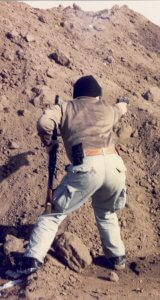
Security Guard Flashlight Carry–See Neck indexed.
SFI / CCI Flashlight Technique—Neck Indexed is sometimes called SFI / CCI, as it was made popular by former Navy SEAL Ken Good of Sure-Fire Institute and Ken’s partner at Combative Concepts, Inc (CCI), former Navy SEAL Dave Maynard.
Semi-automatic–means self-loading. After you fire, the gun sticks another live round in the chamber, but waits for you to move the trigger to fire again.
Shock Threshold–A term I first heard used by Jeff Gonzales, a former Navy SEAL. When a person keeps receiving new stimuli “out of left field” in rapid succession, before they have completed processing the previous stimulus through their OODA cycle, they tend to “vapor lock,” and are less capable of formulating an effective response, at least in the short term. A SWAT team, for example, might drop a “flash bang” distraction device in a back window immediately before another DD in the room they are entering immediately before tackling or shooting a hostage taker.
Shooter’s Pocket–The gap on the sides of your body armor, underneath the armpit. Because the arms normally hang down, armor that comes up too high on the sides is extremely uncomfortable and pinches your brachial arteries causing your arms to fall asleep. Accordingly, manufacturers cut them low on the sides. Bullets often slip past body armor on the sides through that gap (sometimes passing through an arm first). The Shooter’s Pocket is also where we do Needle Decompression on casualties with Tension Pneumothorax who are still in their body armor (see TacMed Terms).
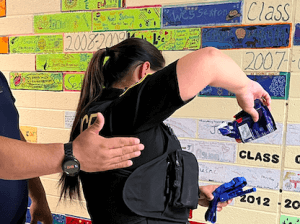
Shooting Sling–a long gun carry strap, usually a 2-point (see Sling below), that has a loop you can wrap around the back side of your biceps to help you stabilize your hold. We all know (or should have learned in elementary school) that the triangle is a very stable shape–which is why you see a lot of triangles in bridge construction, for example. Your support arm forms two sides of a triangle supporting the front of the rifle. When you are “slung up” or “wrapped into” the sling, the sling forms the third side of that triangle, which helps to steady your hold.
Sighted fire–Aligning the pistol with the target using the sights. Happens most of the time on the range, but only rarely in an actual fight, for multiple reasons. Sighted fire is essential at longer ranges, when the target is small (for example, ankles under a car), or in some hostage situations.
Sight line–A straight line, running right down the center of your scope or other sighting system. Two things to remember about the sight line of a scoped rifle:
- It starts about 1.5 inches above your bore line, and
- if the image you are seeing through the scope is not centered in the scope, your eye is not on that line, which can cause errors in aiming.
The bore line intersects the sight line in only one place, very near the initial intersection. Absent wind, spin drift, and other lateral changes, the trajectory intersects the sight line in two places (the initial intersection and the zero).
Single Action (SA)–the trigger only performs one function, releasing the hammer or striker.
SLA–See Symbionese Liberation Army
Sleeper–similar, but not necessarily identical to, a Layoff Man. A sleeper is a person who seems like a bystander or John Q. Public but is covertly ready to act or respond as necessary. In the movies, a Sleeper is a covert operative from another country who has lived her or his overt role so well for so long, they become torn, perhaps even reluctant to act, when called upon by the ones who sent them to perform their mission. In reality, a Sleeper can be a good guy. For example, nearly every single time I flew on commercial airliners from 1996 to 2017, I was armed. Why? Because as a federal agent, I could be (after 9/11, it was highly encouraged). When I was armed in flight, I was a de facto air marshal. Everybody who was armed on board was introduced to the cockpit crew and anybody else onboard who was flying armed, for obvious reasons. After the rebirth of the Federal Air Marshal Service in the wake of 9/11, I would occasionally fly with FAMs. When we met with the FAMs before a flight, they would brief us to act as sleepers. The FAMs would handle any in-flight disturbances. We were not to get involved, but rather pretend to be a regular passenger and watch their back in case the disturbance was a ruse to identify the FAMs, creating opportunities for other terrorists (Layoff Men) to sneak up behind, attack, and disarm the FAMs.
Slicing the Pie–Another term for Panning. Scanning a room from the outside, as you move in a semicircular direction around the outside of the door. Taking it in one slice at a time, you can see most of a room (except what’s on the other side of furniture) before ever stepping foot inside the door.
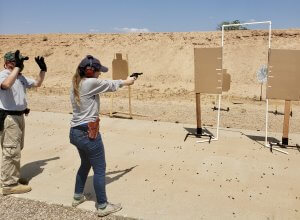
Slide Locked Loading–One of two ways to load a pistol (the other being Slide Forward Loading). An administrative procedure in which a you lock the slide of a cleared pistol to the rear before inserting a charged (loaded) magazine and send the slide forward to chamber a round.
Slide Locked Reload–A Reactive Reload (see). When the slide has locked open because you shot the gun dry, and probably need to reload ASAP. Not to be confused with slide locked loading (without the “re-“), an administrative procedure detailed above.
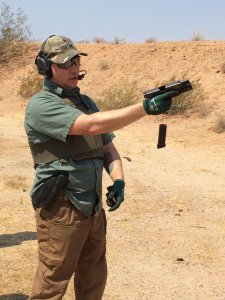
Sling–A carry strap that you can use to hang a long gun off your body, while freeing your hands to do other things. Some slings can also be used to stabilize your shooting position as an aid to marksmanship (see Shooting Sling). There are several different types of sling, the primary ones being
- Single point–Only attaches to the long gun in one place. It may hang off a hook on your load bearing gear, or it may wrap over one shoulder and under the opposite armpit in a loop. The single point required imagination and / or additional equipment to “holster” (get out of your way). Rifles on single points tended to whack the operator in the genitalia when hanging hands free (the real reason Interceptor vests had an optional groin protector). Single points still have some adherents; they might be useful for, say, a medic who may need to take of a first aid pack and put it back on frequently, single points have largely been supplanted by adjustable two points.
- Two point–Attaches to the long gun in two places, traditionally near the front and near the back of the long gun.
- Three point–Standard issue on H&K’s 2-hand guns in the 1980s, a 3 point sling attaches to the long gun (or SMG) in two places, but then again back to itself, usually in some sort of sliding arrangement, that lets the operator choose an “angle for the dangle”–basically, which way the muzzle points when hands free. It was a revolutionary idea in its time; I used an MP-5 3-point, quite in contravention of policy, on my M16 when I deployed to Ops Desert Shield and Desert Storm in 1990 – 91. However, the three point was overly complicated. Running a three point to maximum advantage often took hours of training time, and perhaps an advanced degree in mechanical engineering. In a fight, simpler is usually better. By the early 2000s, most serious operators had abandoned the three point in favor of a much simpler, and equally capable, adjustable two point. Ironically, about that time (in about 2005 or so), ever behind the power curve in the small arms arena, the USAF began REQUIRING that deployers be issued a three point.
Sling Arms–One of several ways to hang a long gun off your body with a strap called a sling. In US military marching drill, Sling Arms meant to put the strap (sling) of the rifle over one shoulder, traditionally the right shoulder (regardless of handedness or eye dominance), muzzle up. Although most tacticool operators sling cross-chest, muzzle down these days, there is still a time and a place for one shoulder slinging. Say, you are manning a checkpoint with hours between contacts, and your sling is too short for (or your back is not happy with) cross chest carry. If you choose to sling across one shoulder, muzzle down on the non-dominant side (African Carry) is probably your best option.
Speed Load–Also called a TFE reload. A competition technique with some tactical application for tier 1 operators, and very limited tactical application for armed citizens. IPSC / USPSA Action Shooting competitors, who carry, like, 8+ magazines on their non-concealed competition rig, might dump a partial on the ground and stuff in a full mag while moving between the boxes they must shoot from. It saves a second or two but loses ammo you might need later, if you only have one or two spare magazines in the mall food court. Even if you are behind effective cover, and figure you can always pick it up off the ground if you need it, you might get flanked and have to abandon that cover–leaving that partially full magazine where you dropped it. The only people I can see legitimately using speed loads stateside, outside of competition, might be SWAT operators serving a warrant. They roll heavy on the ammo, have lots of friends with lots of ammo, and if they step in anything bad, it will likely be high intensity over very short duration. They might not want to miss any of it while conserving ammo for later.
Spin Drift–At extreme ranges, bullets from a right hand twist barrel will drift slightly right, and vice-versa. Spin drift is real, but overrated; but most people don’t shoot far enough away for spin drift to be a factor.
Spitzer–A pointy bullet, specifically a pointy rifle bullet, often having a boat-shaped cross section.
Stance–What your feet, legs, and torso are doing when you shoot. When most people say the word “stance,” though, they often use it to include aspects of hold and grip as well.
Stoppage–Technically defined as “an interruption in the cycle of operation,” a stoppage is more loosely defined as a “click,” when you were expecting (perhaps even desperately needing) a “Bang!” A stoppage is like running your car out of gas, something easily remedied, because the gun (or car) is not broken. As opposed to a Malfunction, which (in our automobile analogy) would require the assistance of a mechanic.
The Street–is not any particular street or avenue, or even, necessarily, a thoroughfare. When an instructor says “That probably won’t work on the street,” they are referring to real-world confrontations, as opposed to where we usually practice, on the range. In law enforcement, the street refers to operational activity in the field, as opposed to in the office or station.
Stuffing the Draw–Also called jamming the draw. Something we practice in Heloderm personal protection classes. If a bad guy reaches for a gun, you can (if you are “switched on,” paying attention to the cues, and prepossessing the training and skills) successfully keep him from getting his gun all the way out of the holster or waistband. Then you can maneuver around him, pin him to the wall or ground, and get your own pistol out. Or simply kick, bite, and head butt him senseless. NOTE THAT WE ONLY DO THIS DRILL WITH INERT / DEMILITARIZED PISTOLS OR REPLICAS.
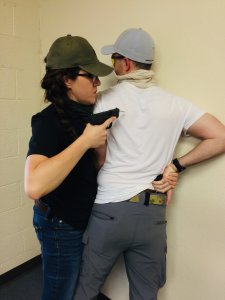
Suicide Bomber–the third-world equivalent of a guided missile. Also known as a homicide bomber, since massive homicide is their intent; suicide is merely part of their method. The LTTE (see) did not invent the concept (the Japanese kamikazes were, in effect, suicide bombers) but the LTTE is widely regarded as perfecting and popularizing it among guerrilla / terrorist organizations. 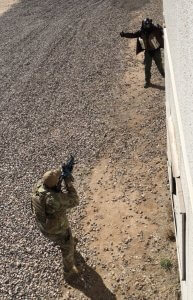 Suicide bombing is one type of mass killing in which women have made some strides. Females sometimes become suicide bombers after being widowed, although the Tamil Tigers carried out one of their most successful assassination attempts with a couple. The woman was in front, wearing the bomb; the man held her from behind and essentially directed most of the blast toward the intended victim with his own body. Not much of the above is really important to you. Suicide bombers are becoming a thing on our shores, occasional predatory sharks riding the massive wave of predominantly peaceful refugees from failed nation states. Bombings will also become more prevalent as government elites succeed in their (systemically racist) efforts to make firearms ownership a bureaucratic privilege limited to the wealthy. The main things you need to remember about suicide bombers are:
Suicide bombing is one type of mass killing in which women have made some strides. Females sometimes become suicide bombers after being widowed, although the Tamil Tigers carried out one of their most successful assassination attempts with a couple. The woman was in front, wearing the bomb; the man held her from behind and essentially directed most of the blast toward the intended victim with his own body. Not much of the above is really important to you. Suicide bombers are becoming a thing on our shores, occasional predatory sharks riding the massive wave of predominantly peaceful refugees from failed nation states. Bombings will also become more prevalent as government elites succeed in their (systemically racist) efforts to make firearms ownership a bureaucratic privilege limited to the wealthy. The main things you need to remember about suicide bombers are:
- They will be wearing bulky clothing, even when not appropriate for the weather.
- They may look scared, distant (thousand yard stare), resigned, or even happy. The man who drove the truck into the USMC barracks in Beirut was reported by witnesses to be grinning from ear to ear, especially as he got closer to his target.
- They WILL have a handler who will execute them with a cell phone if they appear to be losing their nerve. The handler will be on a direct line of sight with them, even if using binoculars.
- “Dead man” switches, which spark off the device when pressure is released, are a real thing, but not as common as they are in the movies and TV.
- Do NOT shoot a suicide bomber in the center of mass. If the reasons for that are not patently obvious to you, perhaps you should not be toting a gun around in public. If you have positively identified a suicide bomber, shoot them carefully in the head.
The greatest unsung heroes of the GWOT (Global War on Terror) are the security professionals who tackle suicide bombers to keep them away from innocents, often losing their lives or limbs or brains in the process.
Supine–Lying on your back. It’s harder to move scooting around on your back than it is to crawl around Prone, but if you are down and bushwhacked at close range, it’s far easier to track the bad guys with your muzzle from on your back.
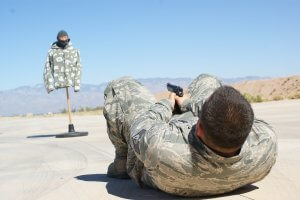
Support hand–The hand that does not need to be on the pistol. Usually, but not always, your “weak” or non-dominant hand.
Support Side–Your NON-dominant side. We used to call it your “weak” side, but you should not have a weak hand or arm. Changing our words will not make that so, but extensive support side practice will. Your “Support” Side may or may not be actively engaged in supporting your dominant hand or arm. Clint Smith calls the non-dominant side the Opposite Side.
Survey Course–A class which provides a broad overview of a situation or condition, and options for response. Students are exposed to as many different concepts as possible in the limited time allotted. For example, you might be taught several different ways to do a proactive reload. It is then incumbent upon the students to choose the methods they think will work best for them, and practice those skills and drills after the class, till they become reflexive. As opposed to a Limited Skills, High Reps course. Many of Heloderm’s intro-level offerings are Survey courses.
Symbionese Liberation Army (SLA)–A radical left wing terrorist organization active in California during the 1970s. Most infamous for kidnapping a newspaper heiress who later joined their ranks, the SLA also robbed banks, stole cars, and assassinated Marcus Foster. As a kid in the 1970s, I cut out articles about law enforcement efforts to stop the SLA, and actually kept a little dossier on several of the known or suspected SLA members. It also had articles on how a Secret Service agnet saved President Ford from assassination. My sister found it decades later when cleaning out my dad’s house. I had no idea, back then, that I would end up as a Special Agent on an FBI taskforce hunting domestic terrorists.
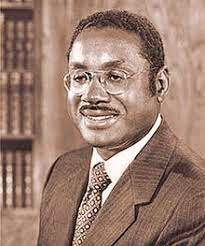
Tamil Tigers–see Liberation Tigers of Tamil Eelam
Tang (of a Pistol)–In Gunspeak, a Tang is the curved upper rear portion of a pistol’s frame or lower receiver, just below the slide. See Encyclopedia of Edged Weapons Terminology for the Tang of a knife or sword.
Target Focused Shooting–keeping both eyes open, focused on the specific part of the threat you want to hit, rather than any parts of your own pistol. Likened to throwing a ball at a basketball hoop–you look where you want the ball to go, rather than at the ball, as you do it. Essential in point shooting, but also best when using reflex sights such as the Trijicon RMR. Most fights start as close range, surprise ambushes. In such a close range, dynamically moving Flash Fight, you are likely to be target focused whether you want to be or not, so it’s a good idea to learn target focused shooting principles and practice them. For excellent reading on the subject, try Lou Chiodo’s Winning a High-Speed, Close-Range Gunfight.
Terminal Ballistics–are what happens to the bullet after it hits a target (the intended target, or otherwise). If you have ever hunted large ungulates (big game) you may have some idea how unpredictable Terminal Ballistics can be, despite all the fancy ballistic gelatin tests and the fantastic claims of ammunition manufacturers.
TFE Reload–A Speed Reload. A Proactive Reload where the magazine is not exchanged per se, but rather dumped on the ground and retrieved later if possible and convenient. TFE reloads are dirt simple to learn (TFE stands for Too Freakin’ Easy), and lightning fast. If you take a course from a former Tier 1 operator like Phil Singleton (who stormed the Iranian Embassy in London with the SAS) or MSG Paul Howe (of Mogadishu fame), they are likely to teach you this way to Speed Reload:
- Identify that you have shot some rounds, you do not need to shoot anyone right this second, and you want to have a full gun before leaving cover or panning a corner
- Grab the spare magazine
- Dump the old (partially full) magazine on the ground
- Stuff the fresh magazine into your mag well before the old one hits the ground
- With some weapons systems, such as the MP5 or AK, you would cycle the action after locking in the new mag, to be sure you have a round in the chamber
- Scan your battle space for threats
- If the situation permits (other folks covering you help), stoop down and pick up the partially full magazine, retaining it if possible
Operators like Singleton and Howe advocate speed reloads, because they are used to fighting under certain conditions. Unfortunately, because you might be forced to move to a different position before having the chance to retrieve the mag you dropped in the dirt, TFE reloads are more advisable for those who carry 8 spare magazines and have lots of friends carrying 8 spare magazines, than they are for a lone armed citizen with only 1 or 2 spare magazines. It’s a tool you should have in your kit, but not the method you should practice most, lest it become a habit.
The Drop–See Drop, The
3 Stupids Rule–a method of violence avoidance espoused by defensive tactics pioneer John S. Farnam of Defensive Training International. Farnam analyzed the data and determined that you can avoid almost all homicide attempts by avoiding the three stupids:
- Don’t go to stupid places. If your so-called friend wants you to drive him to a shady apartment complex and asks you to wait in the car while he gets something, that might be a stupid place to be.
- Don’t hang out with stupid people. This includes most drunks and floozies of either gender.
- Don’t do stupid things, like picking a fight over a matter of pride.
There is, as Randy Harris pointed out in his seminal article Dealing with PESTS, a great deal of overlap between the three.
Threat Discrimination–training in which the student must decide, based on the information available (primarily through sensory inputs) whether or not a particular target needs to be shot, before taking the shot if necessary. In contrast, most traditional multiple target drills, such as the El Presidente evaluation, program you to mow down everyone in front of you, something almost never necessary in the real word, which is full of bystanders.
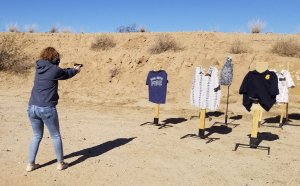
Tom and Jerry drill–A very simple Heloderm demonstration you can do in your kitchen or dining room. Set parameters preventing escape (for example, “the kitchen door is out of bounds”). Defender or student starts on one side of the table, set of chairs, or kitchen island. Assailant role player is armed with a “contact weapon” (it can be a wooden spoon; we use short pieces of foam pool noodle or pipe insulation). Goals are simple: Assailant tries to touch the defender with the “contact weapon;” defender tries not to get touched. Fitness plays a part, but almost inevitably, the assailant eventually wins.
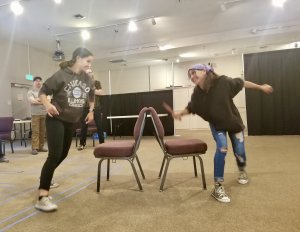
The lesson here: as Steinbeck said, “there is no victory in defense” alone. If you don’t take the fight back to the bad guy (in real life, by drawing a gun, grabbing a knife out of the butcher block, or whacking his forearm with a rolling pin), he will eventually catch up. See FAST above.
Training Incest–When you always train with the same teachers, or the same group of friends, eventually your learning curve levels off becasue you stop learning new things or ideas. It’s true that “advanced techniques are the basics mastered,” and there’s a lot of “tacticool” crap out there on Youtube that simply does not pass a common sense test (and would not pass the test of combat), but you should always seek new experiences and train with different schools. Otherwise, you could fall victim to what we call training incest. Some people have 20 years of experience; others have 2 years of experience 10 times over.
Training Scar–When you’ve practiced doing something that can get you killed in a real fight. In a classic “Pushoff drill,” for example, you strike the target (say, with the heel of you palm), as you might hit a close range assailant to buy a little space and time to draw your pistol. So far, so good. But then you take one step back and draw your pistol, probably shooting it from a full arm extension hold. We only take one step, and only go straight back, for “square, flat” range safety. We hold our arms straight out, only 5 feet from the target, because that’s how we’ve always done it. We’ve always done it that way, because our goal has always been to shoot nice tight groups. But all three of those things, taking only one step back before stopping, staying on the bad guy’s line of attack by stepping straight back, and holding our gun where he can easily off-line it, especially if he advances upon you (something the cardboard target never does), WILL get you killed on the street. They are training scars you actually program yourself to do by practicing that way. In contrast, see Inchworm drill.
Trajectory–the path of the bullet. This is a curved line. It starts on the bore line at the muzzle and drops off from there. Because the bore line is pointed slightly up, the trajectory “lobs” in an arc. Your trajectory crosses your sight line on the way up at the Initial Intersection. Getting the trajectory to intersect with the sight line at 25 or 50 meters is what most people call “zeroing” the rifle, but your actual zero is where the bullet’s trajectory drops down through the sight line again.
Tubular Magazine–a straw-like tube, usually underneath the barrel, where ammunition is stored nose to tail. A coil spring, and circular shaped Follower, push the cartridges or shotgun shells backwards as they are needed to replace the previous round. ONE SIGNIFICANT DRAWBACK OF TUBULAR MAGAZINES IS THAT THE NOSE OF THE BULLET BEING AGAINST THE PRIMER OF THE CARTRIDGE AHEAD OF IT PRECLUDES THE USE OF POINTED “SPITZER” BULLETS. Tube mags are common on shotguns and lever action rifles. .30-30 is a common lever action cartridge, which is why almost all the .30-30 ammunition you find had a round nose.
The Workspace–see Workspace, The
Urban Prone–A niche technique made popular by instructor Travis Haley. Urban Prone is essentially a standing position, toppled onto its side, so you can shoot under cars or engage around a corner. If your top leg is forward, knee on the ground, your firearm can be closer to the ground. If you get flanked, you can bring your top leg back, rolling onto your back into a Supine position.
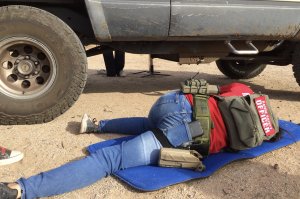
Use of Force–A very complex, and VERY misunderstood, subject. Use of Force is any time you are trying to stop an assailant’s aggression, whether you are threatening to shoot him if he gets any closer, or pushing him away, or kicking him in the knee, or head butting him, or shooting him. Various, often nebulous, laws apply to when and how much force is justified in different situations. We address these concepts and laws, and put them into practice with role playing exercises, in our May / Can / Should: Lawful Use of Force classes. We touch on Use of Force in our other courses as well.
VBIED–Vehicle Borne, Improvised Explosive Device. The third world equivalent of a guided missile. The difference between a VBIED and a walking homicide bomber wearing a suicide IED vest is the amount of explosives that can be delivered to the target.
Victory Model–A version of the Smith and Wesson Military and Police / K-frame .38 revolver, issued to the US military in WWII, and still in Naval / Marine service through the 1980s. It was the military’s equivalent of what was later designated the Model 10.
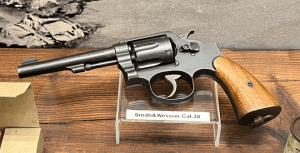
Most of the Victory Models made for the UK had 5″ barrels and were chambered in .38-200. .38-200 was the .38 Smith & Wesson cartridge, with a 200 grain lead bullet.
Most US Victory Models had 4″ barrels. There was also a (relatively uncommon) 6″ barreled version. About 500 2″ versions were made (primarily for the OSS).
The main version used by the Navy & Marines (and to a lesser extent the Army) were chambered for the .38 S&W Special cartridge (technically, the .38 S&W Special, but not to be confused with the .38 S&W, which is NOT interchangeable). The Victory Model proved very popular with aviators, mainly because it was lighter than the GI .45 (M1911A1). It wound up being standard issue to Navy and Marine aircrews in Korea, Vietnam, and beyond. Lt (j.g.) Rodney Knutsen probably used a Victory Model to shoot two NVA soldiers after he ejected from a Phantom over North Vietnam. Look for a lanyard loop and a “V” stamped in front of the SN on the bottom of the butt. For more information, see Bruce N. Canfield’s “V” is for Victory: The Smith & Wesson Victory Model Revolver.
Volley Fire–was the 18th Century equivalent of the modern assault rifle, which is intended to produce a large volume of fire to keep enemy heads down as soldiers advance upon (“assault”) an enemy position. Soldiers fired in volleys because smoothbore muskets were very inaccurate. Modern rifled bores stabilize the bullet so it flies straight. Smoothbores did not, so the round balls they flung flew erratically like knuckleballs in baseball. If everybody in line stood close together (see close order battle drill above) and fired at the same time, you were bound to hit something. Then you reloaded while the next rank advanced ahead of you (or sometimes over you as you knelt) and fired their volley. And so on.
Workspace, The–For most people, workspace is their immediate surroundings, wherever they work. In Gunspeak, “the” Workspace is up in front of our face so we can monitor what’s going on downrange while leaving our weapons system in view should we need to glance at it during whatever manipulation we are trying to accomplish (usually a reload or clearing a stoppage).
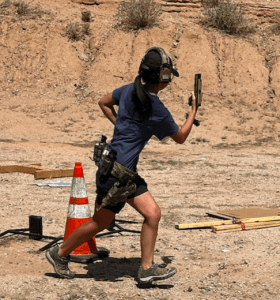
When the pistol is in the Workspace, it’s muzzle up, angled slightly away from you. This allows gravity to help you with extraction & ejection, and enables you to keep your head up on a swivel while glancing at your pistol if necessary. You can also manipulate long guns in the Workspace, but this can be like a flag over your head telling the bad guy where you are. For that reason, Clint Smith is adamantly opposed to muzzle up readies, carries, or manipulations with long guns.
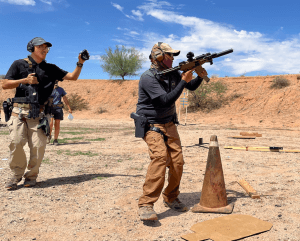
NOTE: Some firing ranges get upset if you practice manipulations in the Workspace. If you must train within such “square flat” range limitations, try to bring the pistol as high as possible while keeping the barrel level and pointed downrange.
Wyatt Protocols–A laundry list of things you might want to do after any sort of ballistic exchange. The order of precedence is determined by the situation. They are sometimes called “the Ts” because they start with T; for example,
- Take cover
- Top off your ammunition
- Talk to 911, bystanders, suspect, or whomever
- Treat injuries
- Take off if the scene becomes unsafe
- Trade up to a better weapon (or across to a backup)
- Tighten your abs if you’re starting to feel woozy
- Transition to police control of the scene without getting shot by the good guys
The X–Where you were when the attack started. Most fights start as ambushes. The X is the kill zone of the ambush.
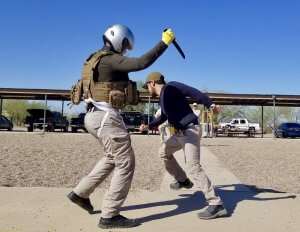
If some of the above definitions and photos look familiar, it’s because many of them are laid out in equal or greater detail in relevant articles on this website. As with everything else on this website, this information is here to help you improve, but it is no substitute for actual practice under the tutelage of a qualified instructor.
